Some of the most unique-looking caterpillars are black. Found across North America, these caterpillars can be hosted by trees, herbs, flowers, and grasses.
Most of these caterpillars are black throughout their caterpillar growth stages. Some of them might only be black at first or towards the last instars of growth stages.
A common sight across trees and even in gardens, these caterpillars eventually become moths or butterflies.
Table of Contents
Are Black Caterpillars Poisonous?
Most black caterpillars aren’t toxic or poisonous. They might appear poisonous when a bright color pattern is seen across their black bodies.
Caterpillars of this color are known to sting, in rare cases. Spikes and urticating hairs can cause mild skin-level reactions in humans.
However, black stinging caterpillars aren’t well documented and it’s best to avoid touching most of them.
Detrimental species or high numbers of caterpillars in the garden can be removed, especially by wearing protective work gloves to diminish the risks of skin-level adverse reactions.
Types of Black Caterpillars
Here are some of the common black caterpillars found both in North America and elsewhere around the world.
1. Spongy Moth Caterpillar
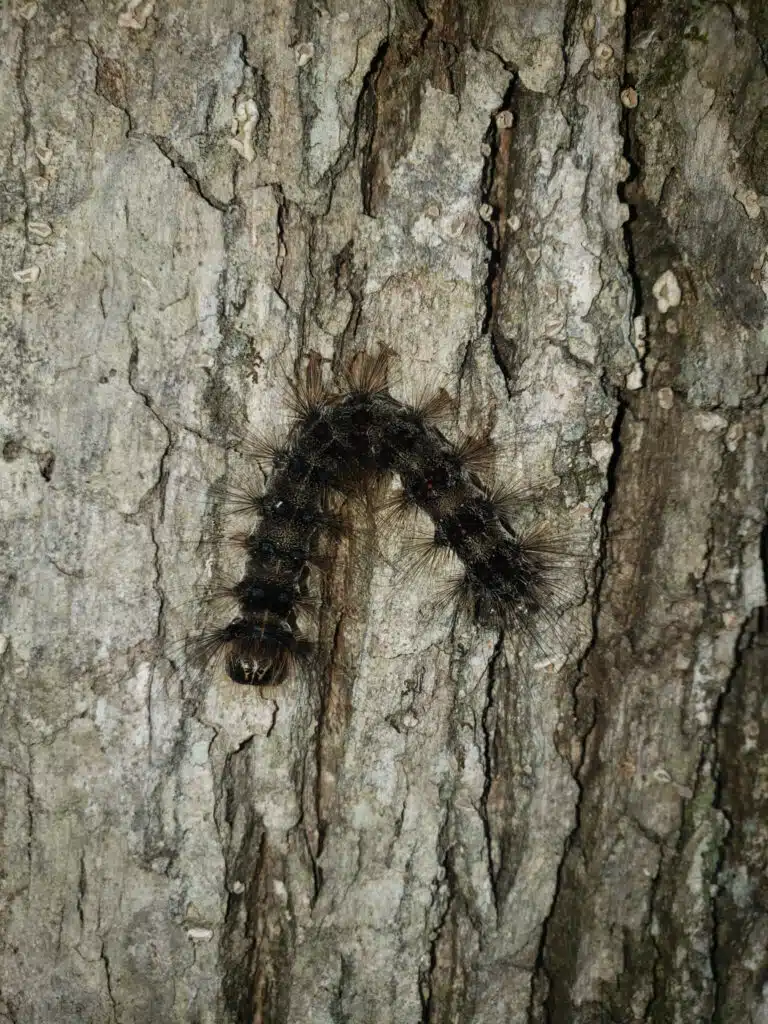
Spongy Moth Caterpillars (Lymantria dispar) reach a black body color with orange stripes on the back in late instars.
Up to 6 instars are specific to this species, which is secretive through its nocturnal nature.
Spongy Moth Caterpillars only show visible leaf damage once they get into their later growth stages or instars.
These caterpillars move up trees at night and come back to lower-level leaves during the day.
Tree damages are considerable within the species. Spongy Moth Caterpillars eat most of the food of their lifespan as caterpillars as they feed considerably less as adults.
2. Great Spangled Fritillary Caterpillar
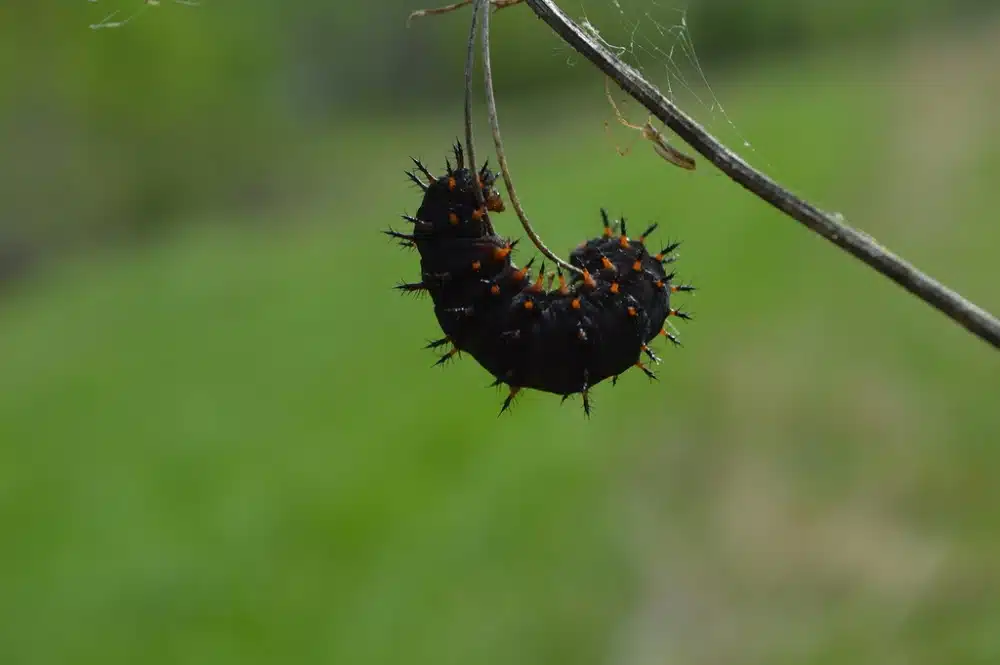
You can find these caterpillars (Speyeria cybele) in open spaces and other dry habitats.
The caterpillar reaches an almost all-black color into its maturing days. Orange or red protrusions are only contrasting their black color.
Female Great Spangled Fritillaries lay eggs next to violets.
These eggs hatch and caterpillars move on to feed on various violets.
Orange and black coloring seen across the caterpillar’s growth stage is then later seen on the adult butterfly which is different shades of orange and even brown.
You may see the adult butterfly from early June when the female starts laying eggs as well.
3. Common Buckeye Caterpillar
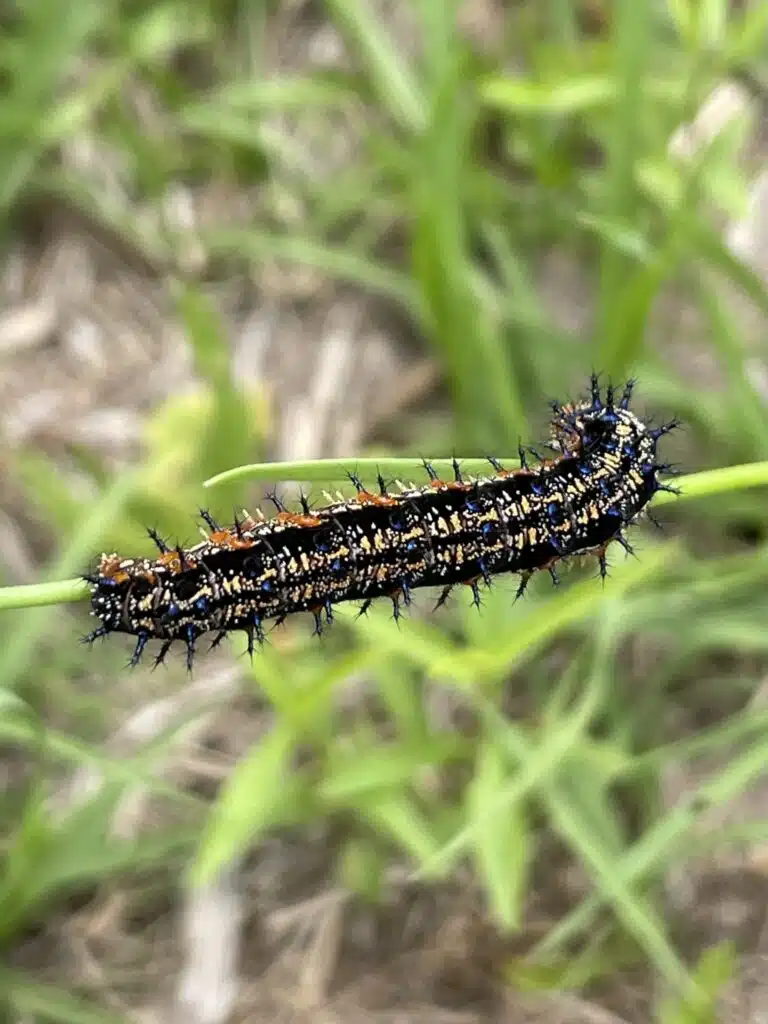
This type of caterpillar (Junonia coenia) can be seen on various host flowers such as false foxgloves.
It has mostly black coloring with white patterns and orange marks.
The species begins life as a green egg. Adult Common Buckeye butterflies are mostly brown and black, but orange coloring is still seen on the adult, as on the caterpillar.
A wide range of habitats is specific to this species, as are its host plants.
Common plantain is among the typical host species found throughout North America for these caterpillars.
4. Painted Lady Caterpillar
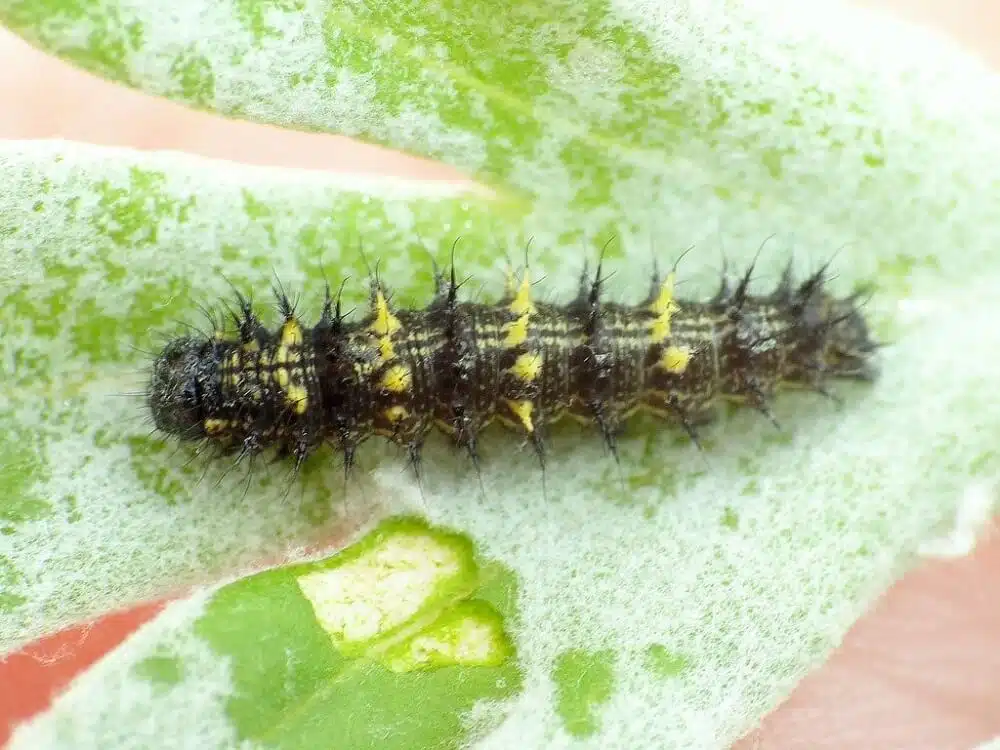
Beginning life as a green egg, the Painted Lady Caterpillar (Vanessa cardui) slowly grows into a black individual.
The mature caterpillar is almost completely black, after going through a gray phase.
Bright bands contrast its black body which also shows black bristles.
1 to 3 generations are seen each year for the species, depending on its location.
While mallows are generally accepted as host plants, Painted Lady caterpillars feed on a wide range of plants.
More than 100 host species have been documented for this type of caterpillar.
Only partial black coloring is further distinguishable on the adult butterfly.
5. American Lady Caterpillar
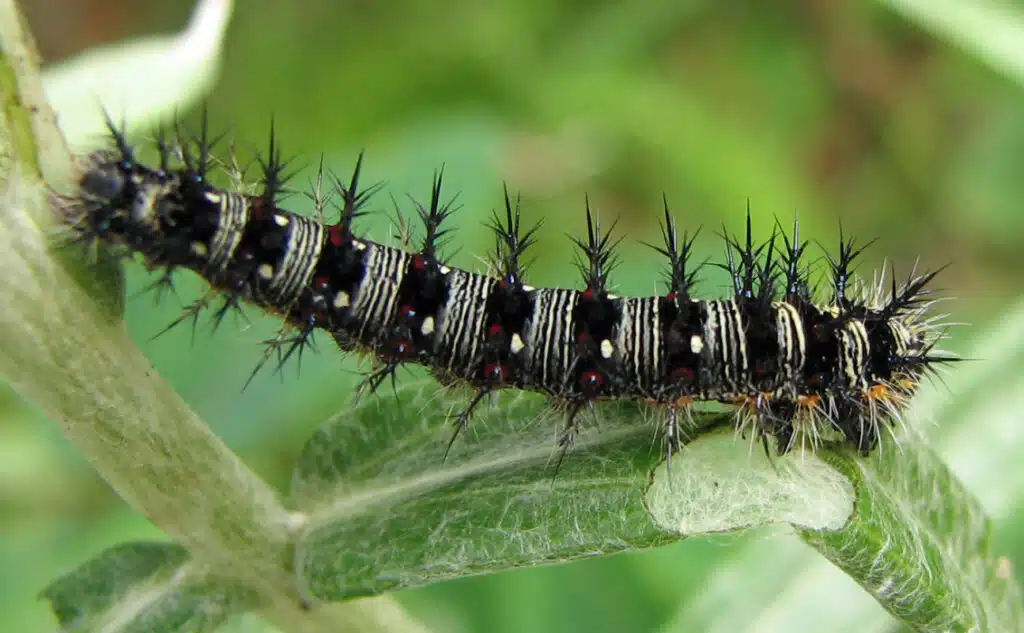
American Lady Caterpillars (Vanessa virginiensis) are very similar to Painted Lady Caterpillars. Both species are black American Lady Caterpillarbright bands contrasting the body.
Small white dots are further distinguishable on the American Lady Caterpillar.
These caterpillars are seen in at least one generation per year. Multiple broods are specific to warm climates such as those in Florida.
You can see the caterpillar in silk-made protective structures on top of flowers.
These silk constructions fuse multiple leaves of host plants to offer a protected shelter with food for the growing caterpillar.
6. Red Admiral Caterpillar
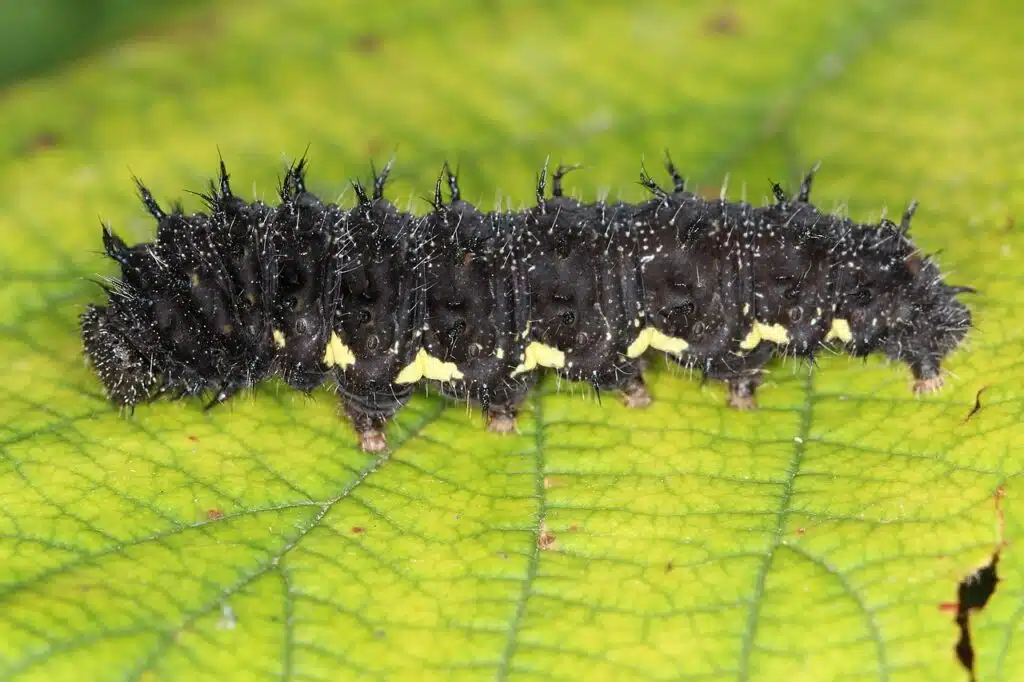
Red Admiral Caterpillars (Vanessa atalanta) have black coloring specific to their first instar. This is the time when the caterpillar is fully black, as are its bristle-like hairs.
The color lightens to brown and black nuances as the caterpillar grows.
The spines of these caterpillars are seen from the first instar to the last instar.
Black and brown coloring lingers on into adulthood. Red Admirals have black, white, brown, and orange coloring as adult butterflies.
Intervals between broods can lengthen in certain areas of the world. This is caused by global warming, excessive heat, and long drought periods.
7. White-lined Sphinx Caterpillar
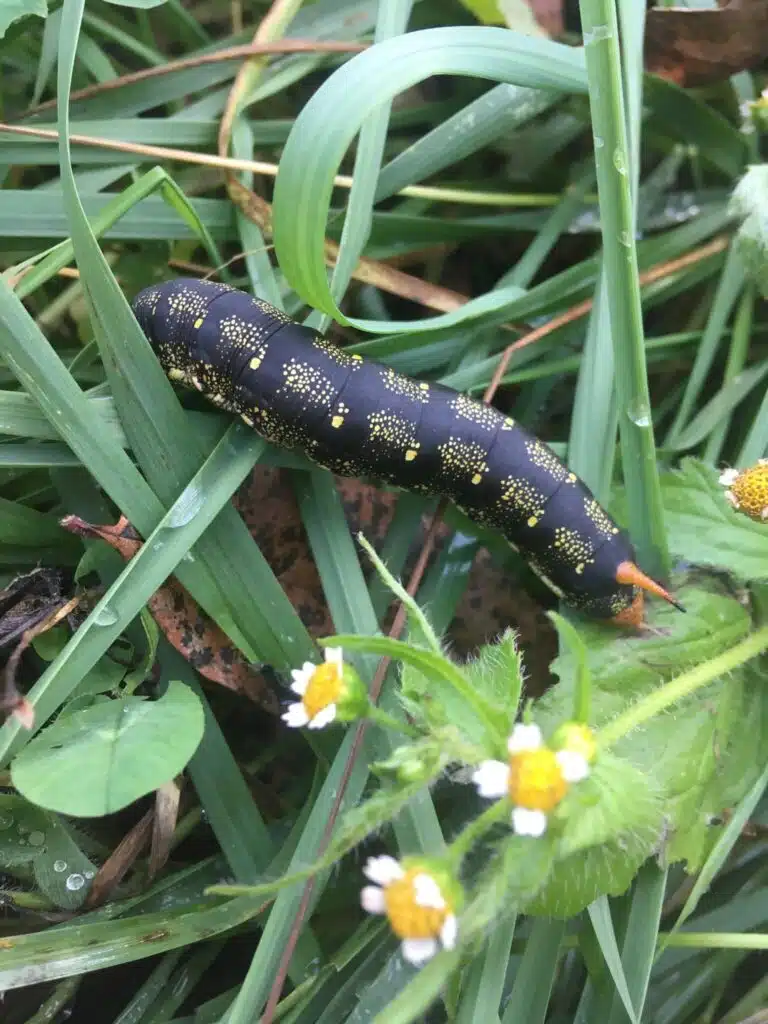
Found in all types of habitats, these caterpillars (Hyles lineata) are a common sight in deserts, parks, gardens, and next to woodlands.
The black color with yellow marks is specific to the black period of the caterpillar, which can also be green.
This species is seen on various types of shrubs, flowers, and plants.
Evening primrose is among its most common hosts.
The species is seen on low shrubs and vegetation in deserts and even on trees elsewhere.
Elm and grapes are among their hosts outside of deserts.
Violet flowers such as elegant clarkia are among its most common floral hosts.
8. White Peacock Caterpillar
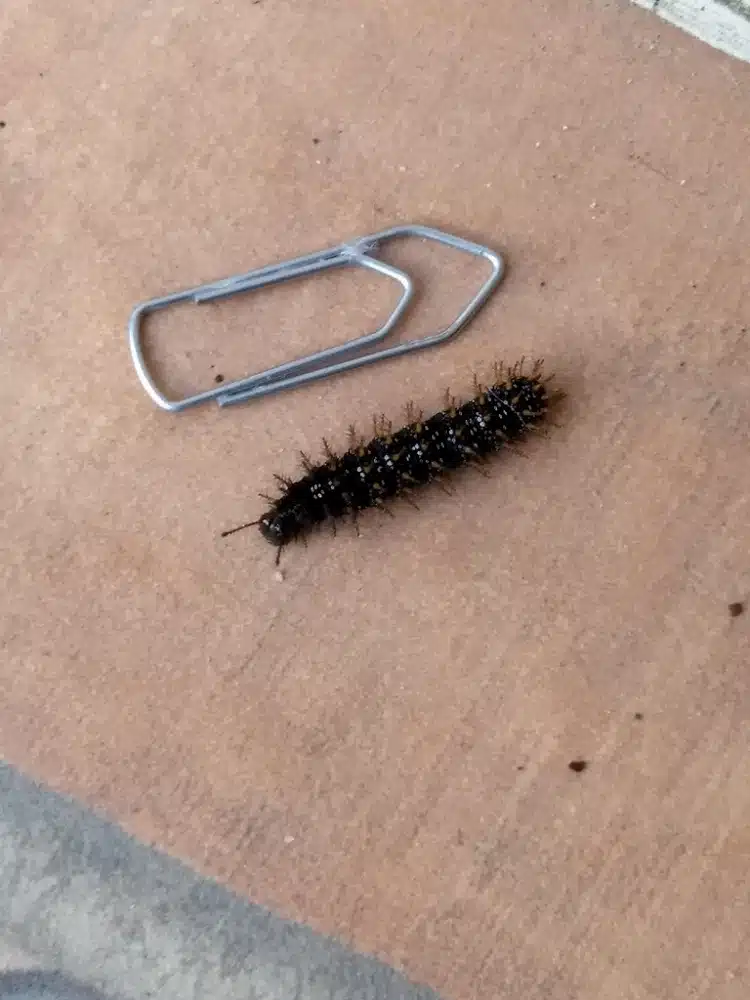
Common in Southeastern US habitats as well as in other regions of Central America, White Peacock Caterpillars (Anartia jatrophae) are almost all-black.
A black body with black bristles is specific to this species. Orange dots on the base of the bristles further contrast the coloring of the species.
You can find White Peacock Caterpillars on water hyssop and various types of rueallia.
Yellow, brown, and white colors are specific to this species as an adult while black remains a marginal color decorating the wings.
White Peacocks are highly aggressive when it comes to protecting the habitat of their caterpillar’s host plant.
9. California Tortoiseshell Caterpillar
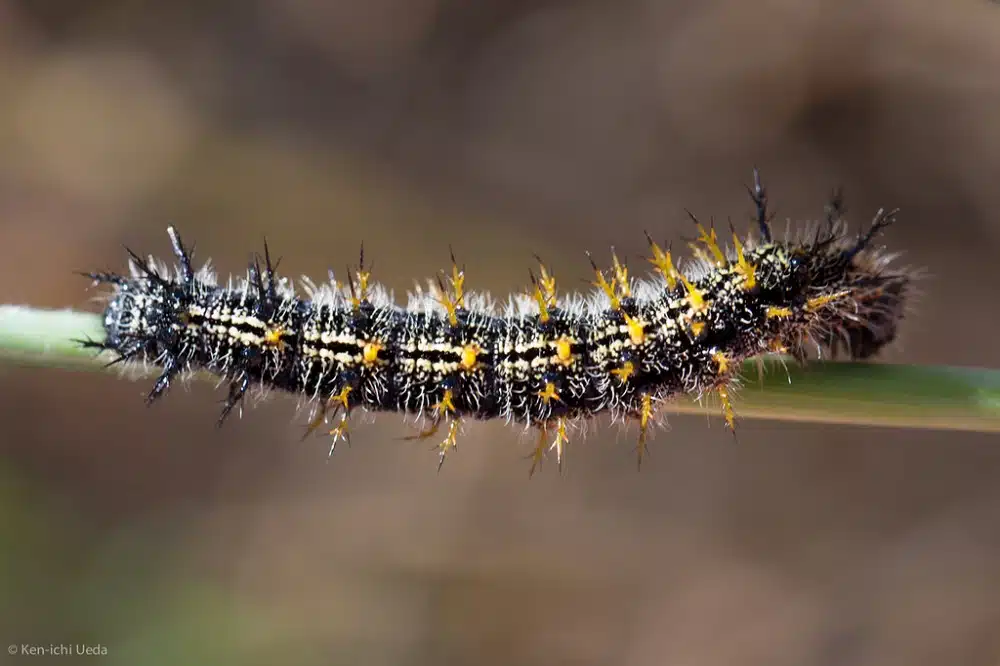
This type of caterpillar (Nymphalis californica) is native to California and other regions West of The Rocky Mountains.
It has a black base color with yellow-orange coloring in the form of dots at the base of its bristle-like hairs.
The combination of orange and black coloring is characteristic of the California Tortoiseshell adult as well.
Among caterpillars, the California Tortoiseshell caterpillar is known for having very specific preferences when it comes to feeding and host plant choices.
The species is exclusive to wild lilacs.
You can find it across woodland edges, specific chaparral habitats, as well as in dense vegetation areas.
10. Pipevine Swallowtail Caterpillar
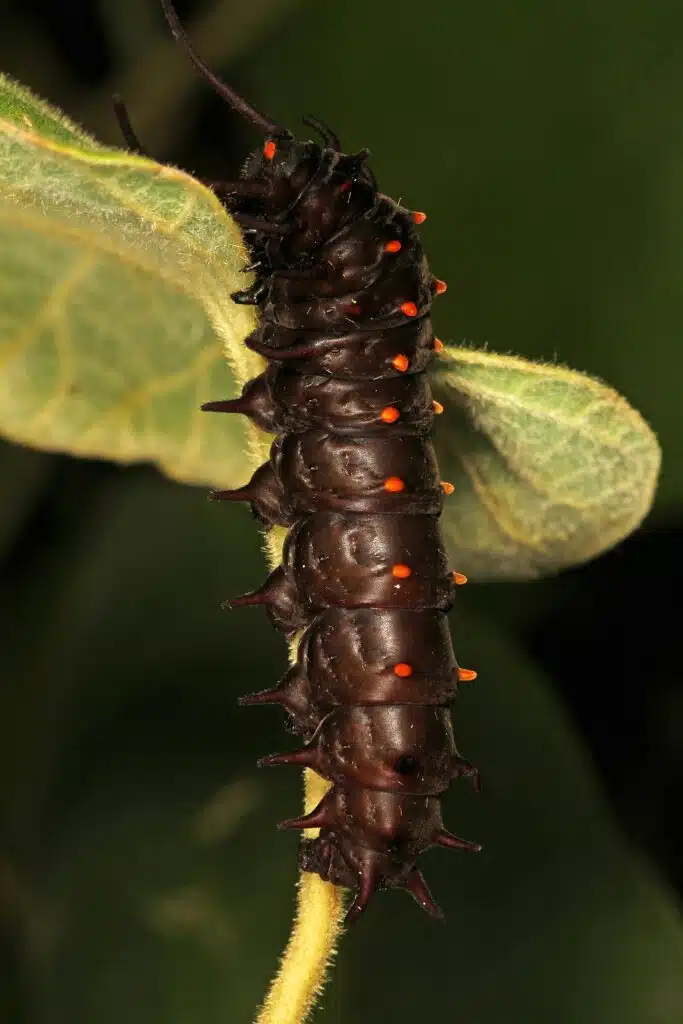
Eastern and Southeastern US states are home to the Pipevine Swallowtail caterpillar (Battus philenor).
This species begins life as a small brown caterpillar. Its brown nuance tends to darken to the point it reaches a black color with dark brown nuances as a grown caterpillar.
Orange tubercles contrast the dark color of the species.
Feeding on birthwort plants, this species transforms completely in a matter of days when it comes to size.
It begins life as a barely-visible egg to reach a length of up to 4 inches as a growing caterpillar.
11. Malachite Caterpillar
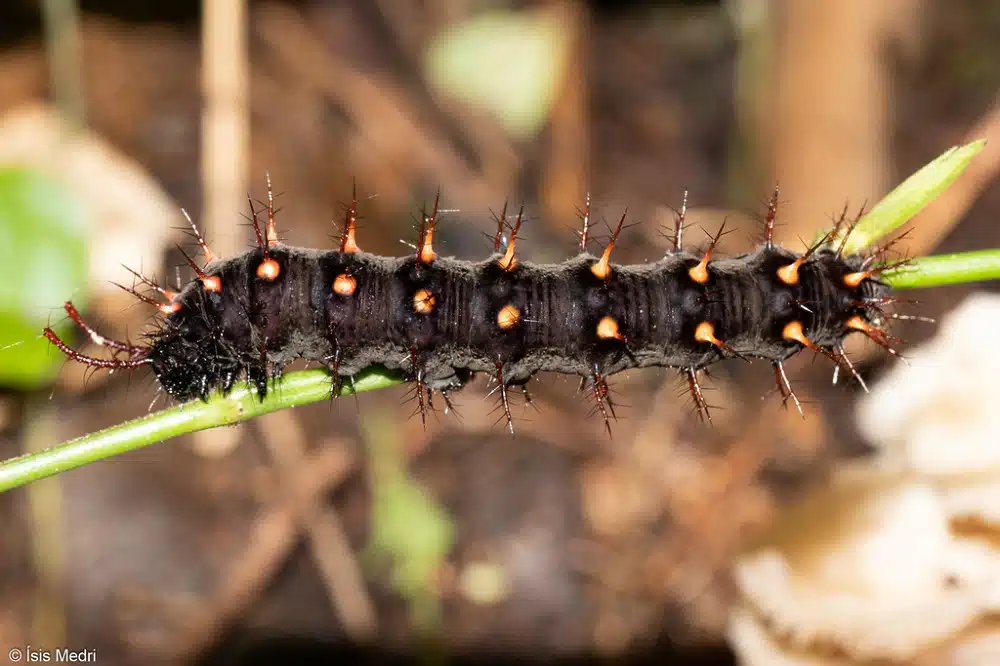
Growing to a length of up to a few inches, Malachite Caterpillars (Siproeta stelenes) have a black base color. Red spots are seen across its body.
These caterpillars are known to be horned.
You can find Malachite Caterpillars across Central American habitats and in some Southern US territories.
Southern Texas and Southern Florida are among the most common regions of the species in North America.
This species starts life as a green egg.
It turns black as a caterpillar to finally emerge as a black and green butterfly.
The species is medium to large as adult Malachite butterflies measure up to 4 inches.
12. West Coast Lady Caterpillar
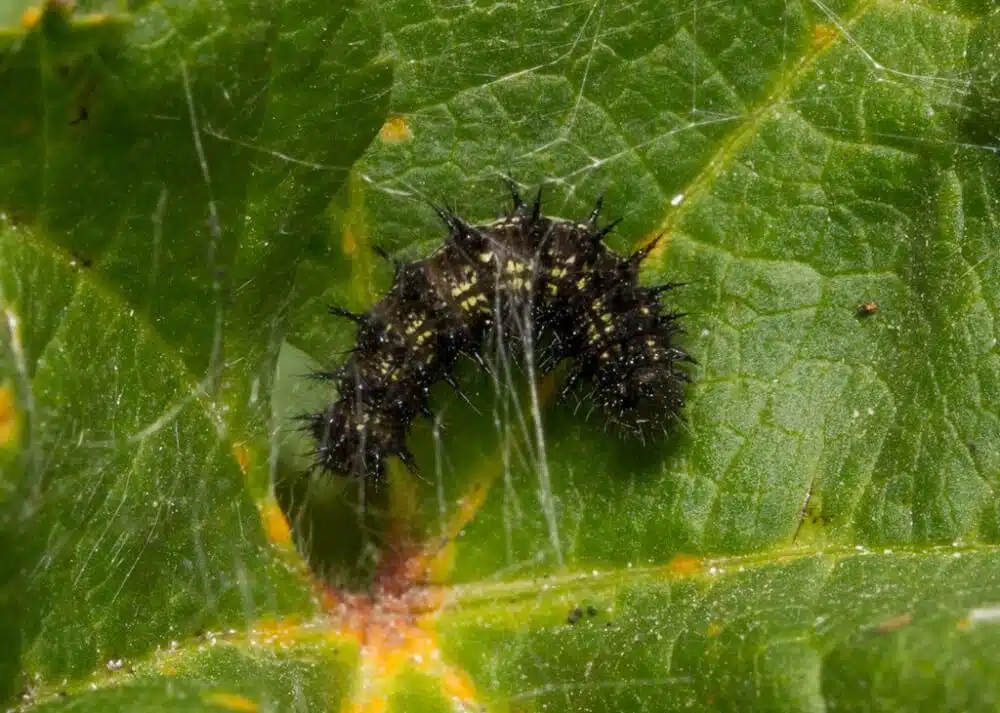
A bright gray-yellow color is specific to the small West Coast Lady Caterpillar (Vanessa annabella). This species grows into a mostly black caterpillar with cream-yellow or orange margins across the body.
The species darkens further just before pupation into a mostly black caterpillar.
Mallow and bush mallow across Western North America are among the favorite host plants for the species.
West Coast Lady Caterpillars are further known to move toward flower nectar as feeding adults.
Adult butterflies mostly inherit black coloring on the forewings.
13. Variable Checkerspot Caterpillar
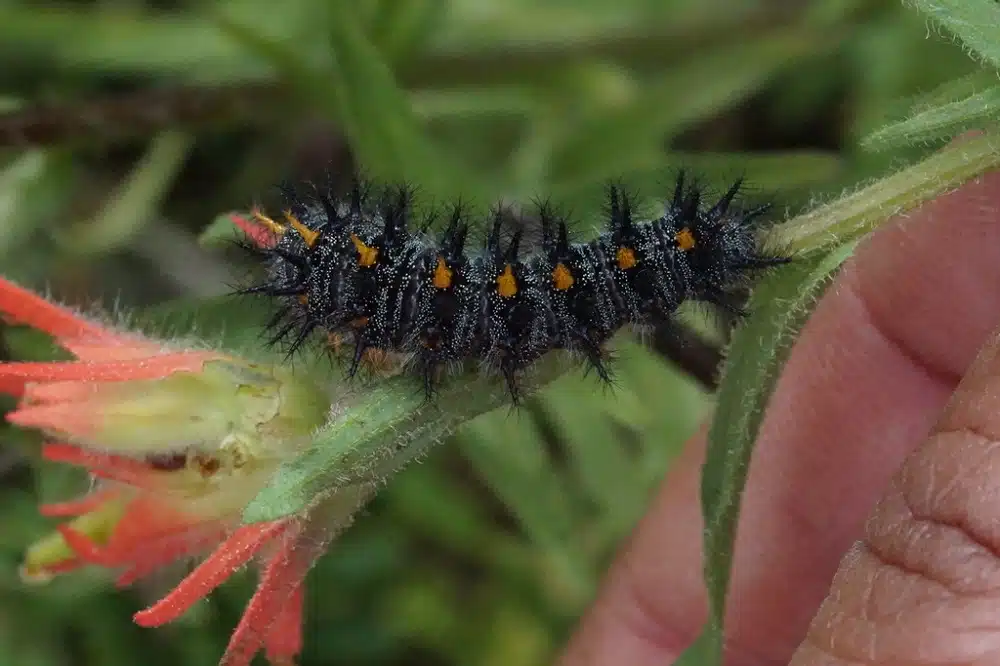
The black base color is specific to the Variable Checkerspot caterpillar (Euphydryas chalcedona).
This species has black and red coloring, similar to its host plant the sticky-monkey flower.
Host plants have an important role in the life of Variable Checkerspot caterpillars.
Apart from serving as plant food for caterpillars, it also helps in the mating process.
Males Variable Checkerspot Caterpillars patrol the area of the host plant where they await females willing to mate.
Found West of The Rocky Mountains, the species has black and white coloring as an adult.
14. Pearl Crescent Caterpillar
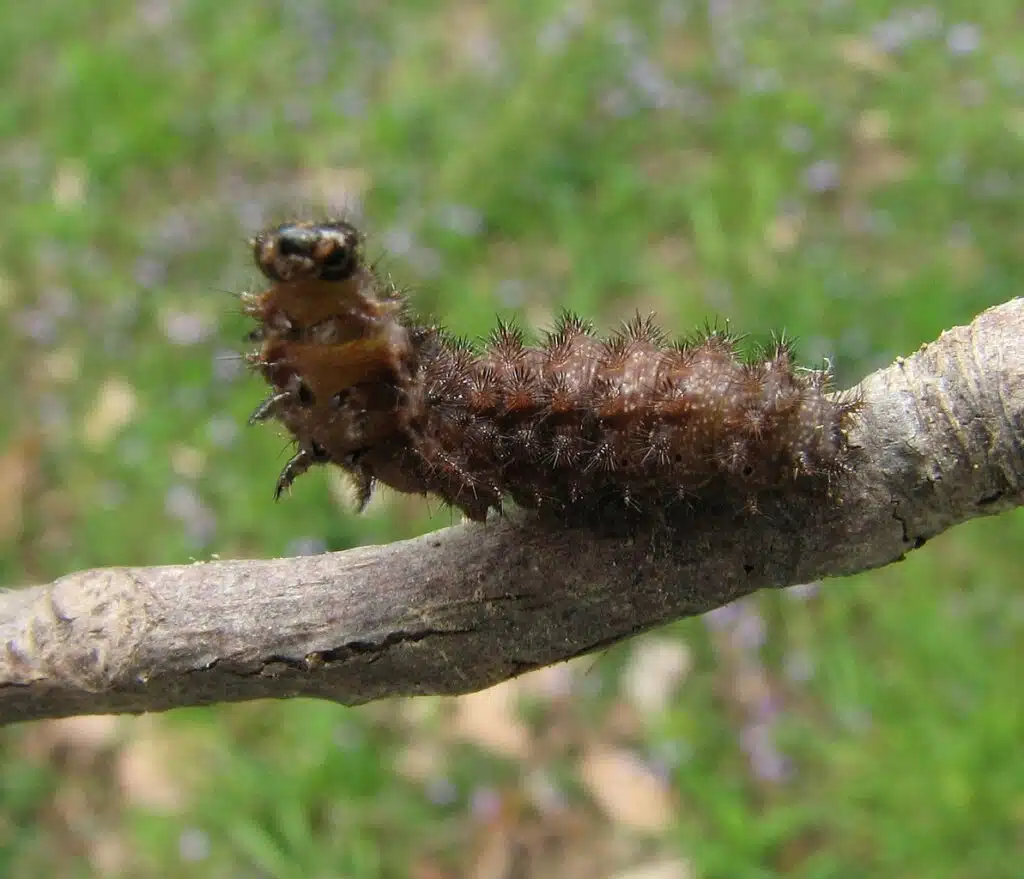
Caterpillars of this species (Phyciodes tharos) have a light brown color which turns black as they grow.
A spotted body is characteristic of the Pearl Crescent Caterpillar. The black body is contrasted by tiny white and brown dots.
Eastern territories across North America are covered in the favorite group of flowers of the species.
The caterpillar prefers to grow and feed on asters.
Several broods of the caterpillar appear up to November in Southern habitats while one brood is specific to Northern US territories.
The adult Pearl Crescent butterfly bears the black color of the caterpillar in the form of visible veins and margins on the wings.
15. Eastern Comma Caterpillar
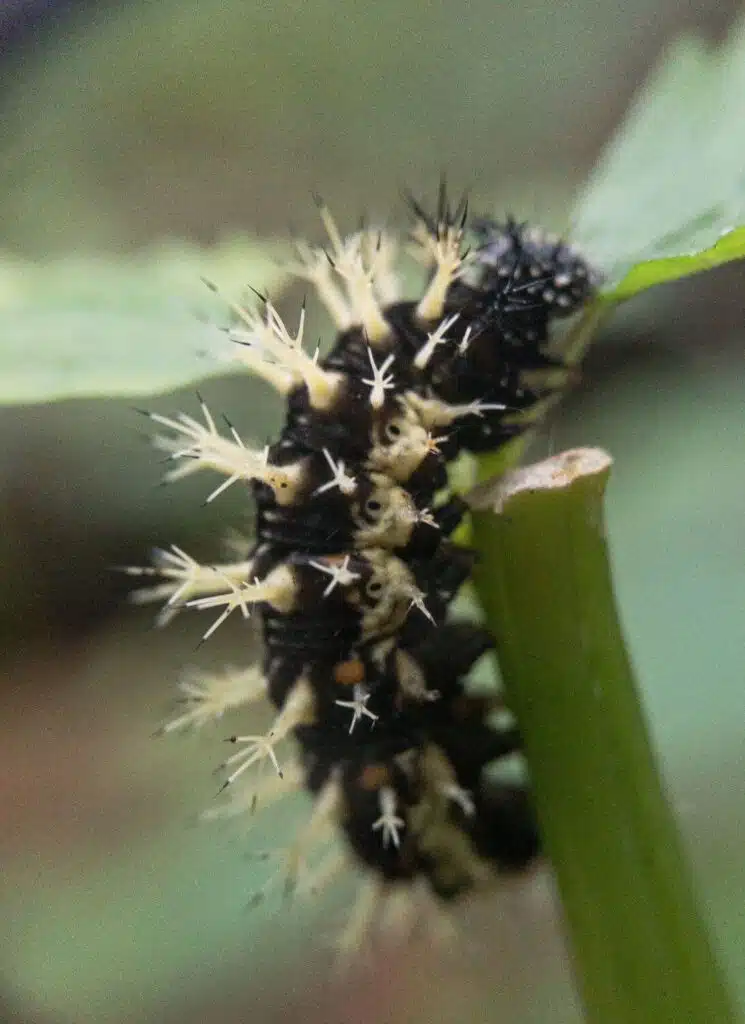
This species (Polygonia comma) represents one of the smallest black caterpillars in the US. A grown Eastern Comma Caterpillar has a maximum length of 1.2 inches.
Black is its dominant color. White stripes and white spines complete the look of the species, together with tiny brown dots.
There are some color variations across the species, mainly between base-black and base-brown nuances.
All morphs of the Eastern Comma Caterpillar have short hairs on the head.
Various species of nettle are the host of these caterpillars. In the absence of nettle, it moves on to elm or hemp.
16. Mourning Cloak Caterpillar
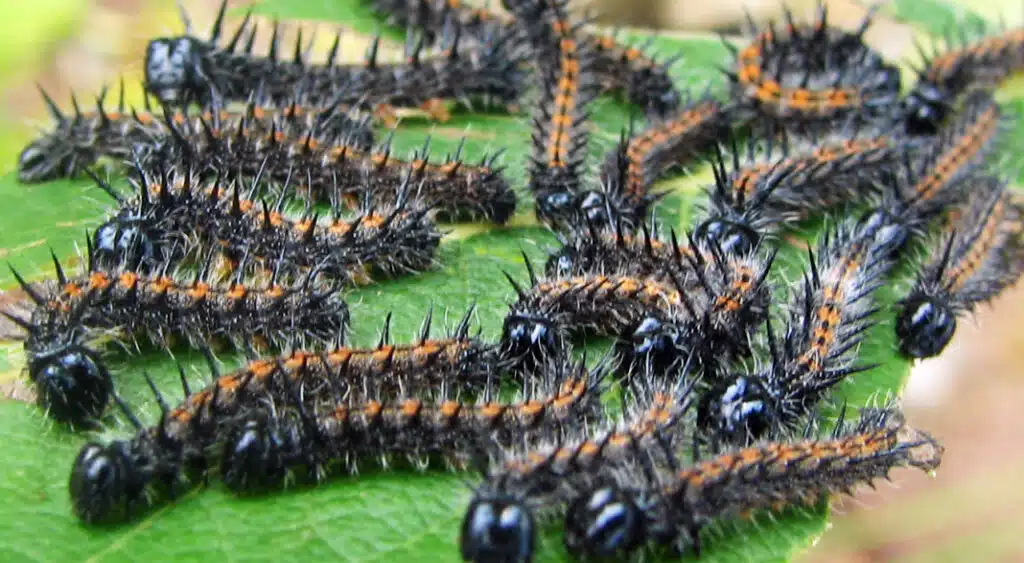
These types of caterpillars (Nymphalis antiopa) are dominated by black colors, much like the adult butterfly.
Many tiny white dots cover the dorsal part of the species. Larger orange spots are further distinguishable on the back of the caterpillar.
Black spines are also distinguished by the species. While not venomous, the species appears dangerous to its predators with these long spines.
Various types of willows are the main host of the species.
Wild willows and exotic willows such as the weeping willow are among its favorite hosts. Similar hosts include poplars, and trees sharing the same habitat.
17. Southern Variable Dart Caterpillar
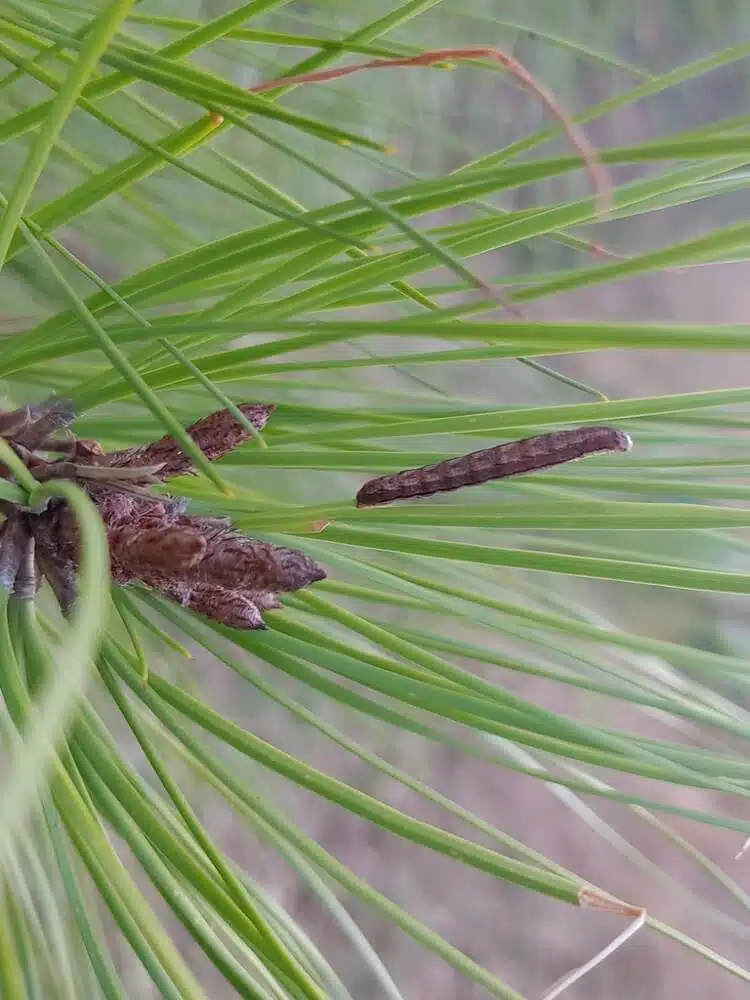
This species of caterpillar (Xestia elimata) is only found in Northeastern US territories.
Born a green species, the Southern Variable Dart Caterpillar eventually becomes dark brown-black.
This is a rare sight species as it lives at higher altitudes. It prefers various types of pine trees as its hosts.
Caterpillars of this genus are also difficult to spot as they’re only active at the beginning of the fall.
There’s only one Southern Variable Dart Caterpillar brood per year.
Dark brown and gray colors are also specific to the adult moth, which also has black coloring across the wings.
18. Question Mark Caterpillar
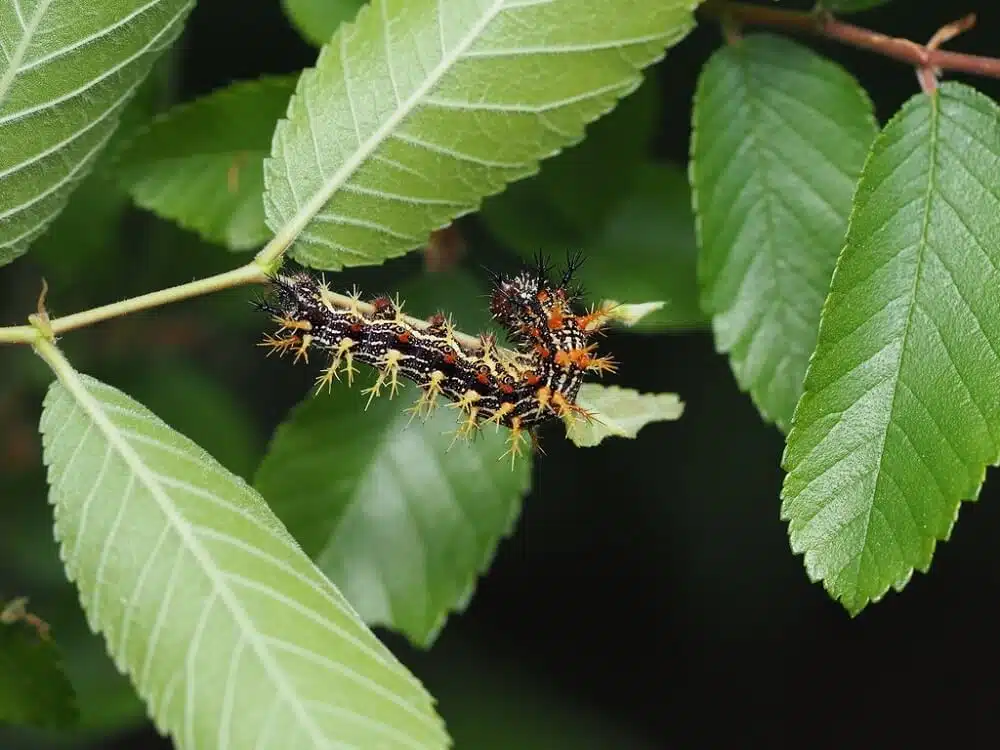
These types of caterpillars (Polygonia interrogationis) are native to North America.
A common sight on trees, they come in different color combinations.
The black base color of the caterpillar exists. It exhibits yellow irregular stripes across its body.
Red to brown coloring is more specific for this species across multiple habitats.
You can find these caterpillars feeding on the leaves of various trees, mainly of a hardwood nature.
American elm is the primary host of the Question Mark Caterpillar.
Damages to the tree are minimal as it doesn’t eat a large number of leaves as it grows.
Elm and hackberry are also hosted trees of the caterpillar, but considerably to a lesser extent compared to elm trees.
19. Mylitta Crescent Caterpillar
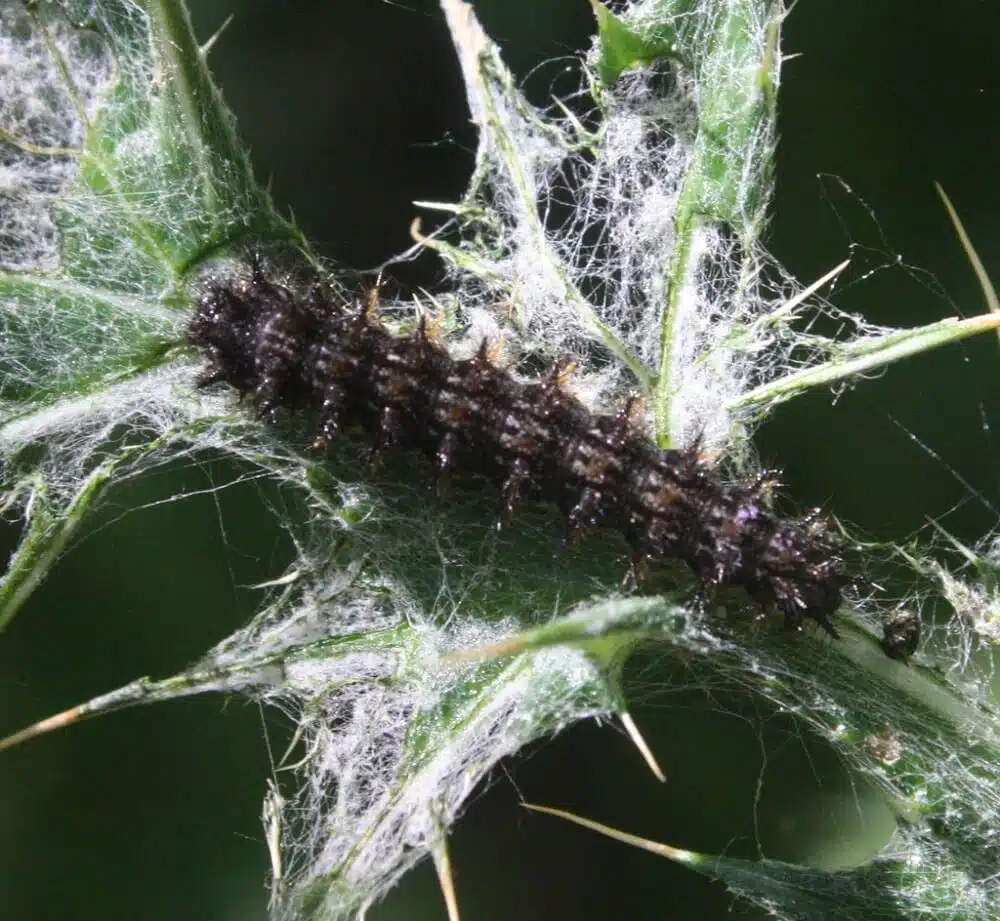
Black color is specific to this caterpillar species (Phyciodes mylitta) to a large extent. Complementary colors include white, yellow, and orange, in the form of dots and stripes.
This species bears much of its caterpillar-stage coloring into adulthood.
Mylitta Crescent butterflies are dominated by orange and black colors.
The percentage of black color coverage is smaller in adult butterflies than in caterpillars as orange is the main color of the adult.
You can find these caterpillars in various dry habitats at different elevation feeding on asters.
20. Agreeable Tiger Moth Caterpillar
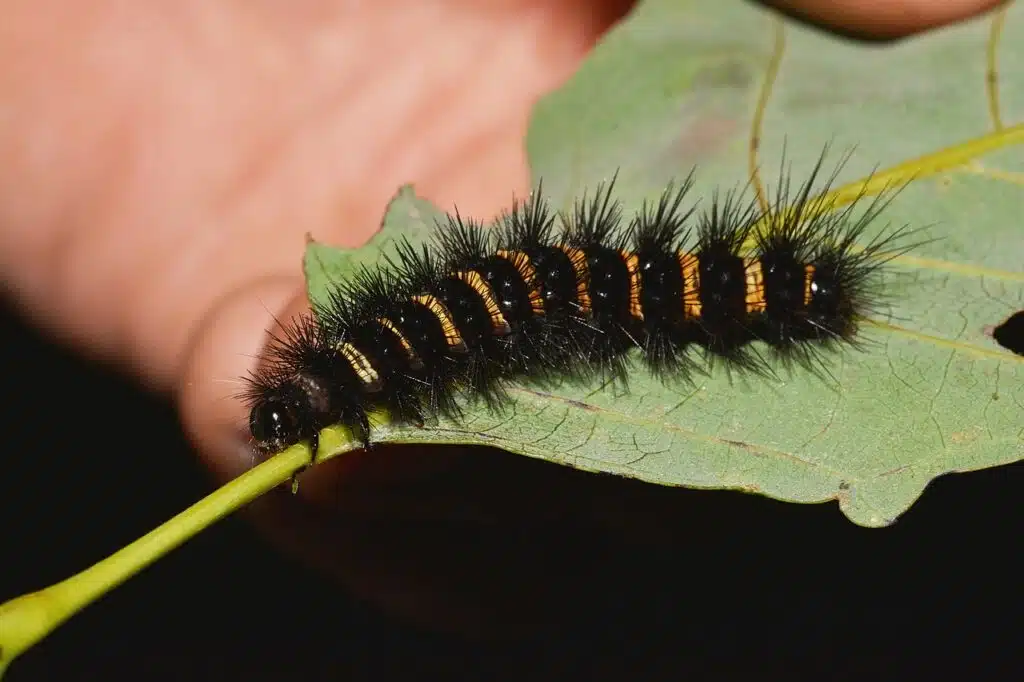
Agreeable Tiger Moths (Spilosoma congrua) are white and tend to stand out as adults.
Caterpillars of the species are completely different as they’re mostly black.
A long black body is specific to this caterpillar, along with yellow-orange bands across.
Black hairs are also seen on the body of the species.
Caterpillars of this species begin life as pearl-white spherical eggs. They have a cream-white color in the first instar while black hairs start to develop in later instars.
The species is only characterized by black body sections in later instars.
21. Silvery Checkerspot Caterpillar
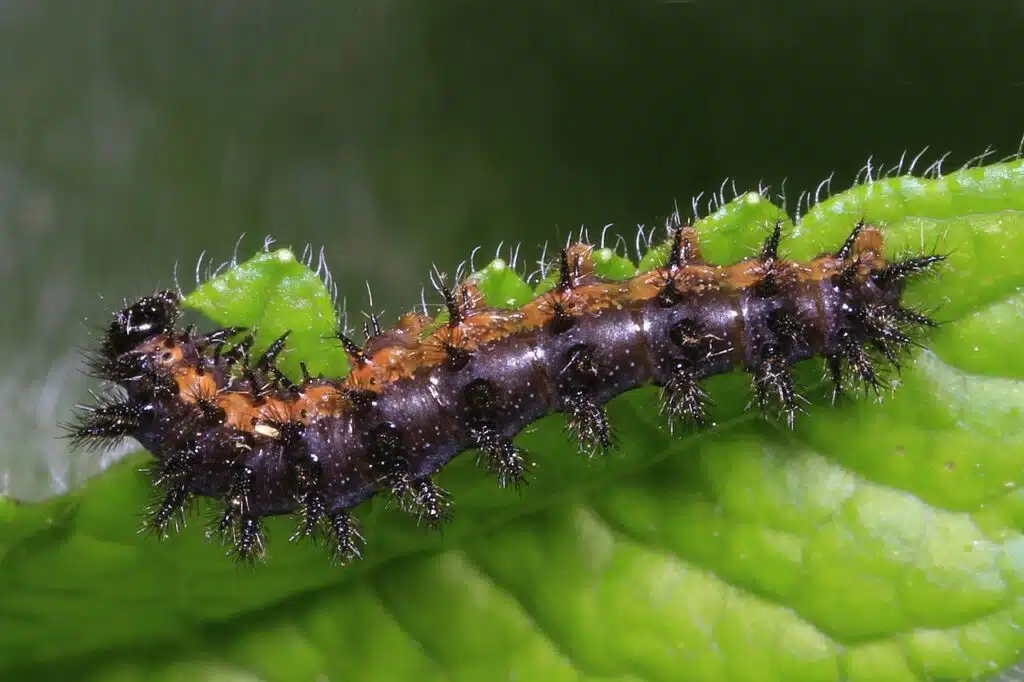
A combination of black base coloring with brown margins is specific to the Silvery Checkerspot Caterpillar (Chlosyne nycteis).
This is a species of caterpillars that carries coloring into the adulthood of the butterfly, which is orange-brown and black.
The caterpillar is seen across multiple confirmed host plants.
It has an extensive habitat and it prefers full sun plant exposure. As a result, sunflower is among its preferred species.
Adults change their dietary preference to flower nectar and more common food sources such as milkweed.
You can only see these caterpillars in one brood, mostly at the beginning of the summer.
22. Giant Woolly Bear
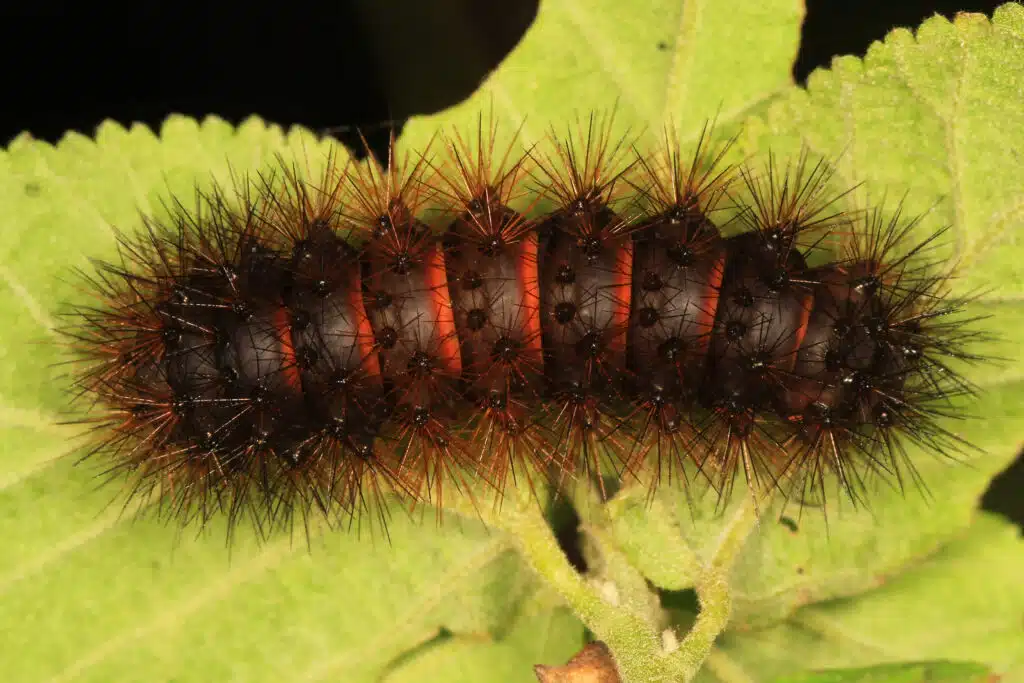
This type of woolly bear caterpillar (Hypercompe scribonia) is sometimes feared for its toxicity. It feeds on various toxic plants, absorbing toxins to their defensive benefit.
Giant Wooly Bear caterpillars begin life as black and red or black and brown species.
The red sections of the body transform into narrower red hairless bands across a mostly black body into late instars.
The species grows on various common plants and vegetables such as cabbage and sweet orange.
Its economic impact is reduced as this species has plenty of natural predators.
Tachinid parasitoid flies are among its most common predators.
23. Wild Forget-me-not Moth Caterpillar
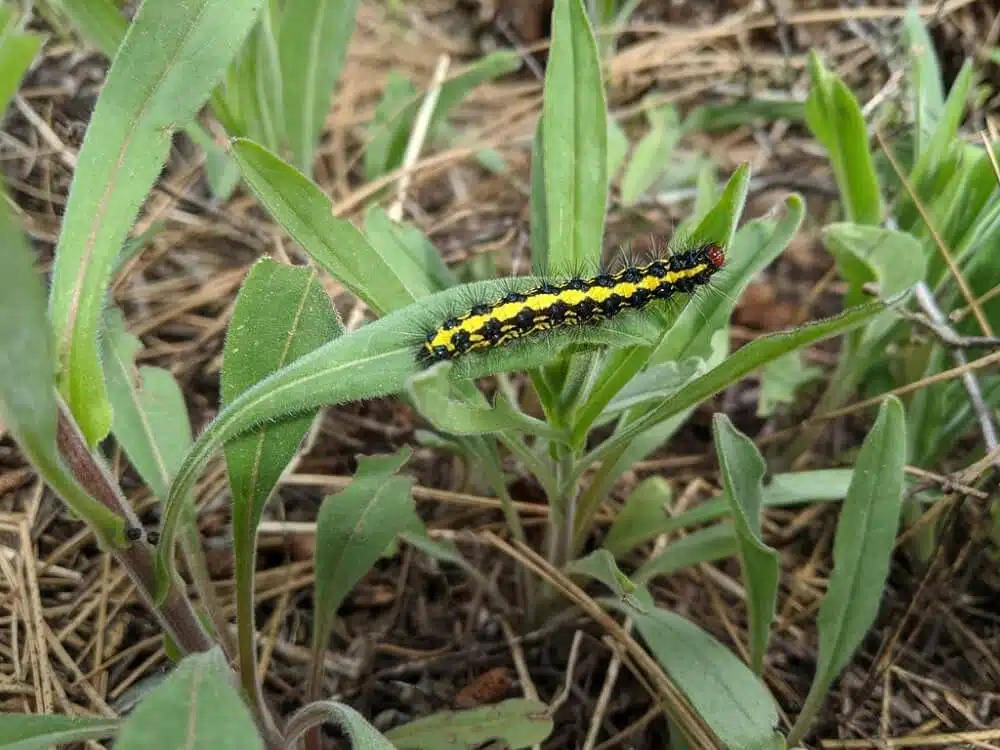
This species of caterpillars (Gnophaela latipennis) have a specific range in Western North America. It prefers the coastal areas of California and Oregon.
To a lesser degree, the Wild Forget-me-not Moth Caterpillar is also seen in Western Nevada and Western Arizona.
A base black color is specific to the species. It features either yellow or green lateral bands of an irregular shape.
Caterpillars of this genus are partially similar to adult moths, which are also partly black.
You can see this species of caterpillar in various coastal habitats, mainly close to forests.
24. Painted Tiger Moth Caterpillar
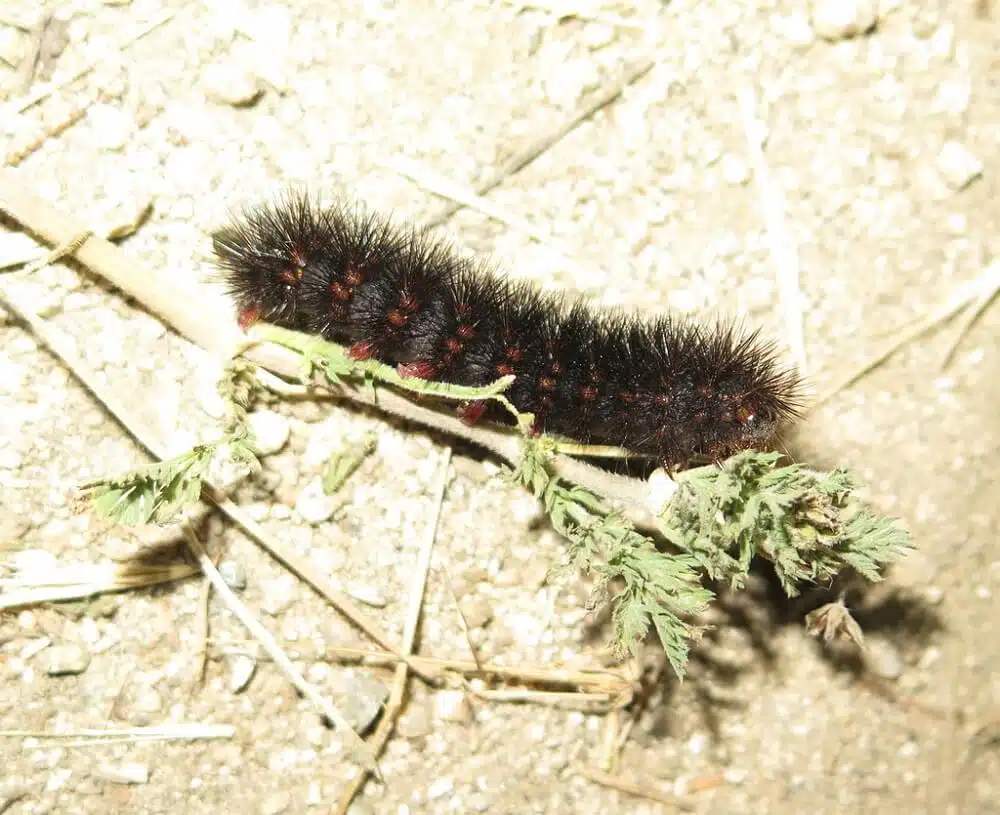
Painted Tiger Moth caterpillars (Arachnis picta) can be minor pests in the garden.
You might see these black caterpillars if you have planted radishes in the garden.
Otherwise, the species prefer lupine-genus plants as a host for its caterpillars.
A base black color is characteristic of the species. Brown sections across the body mark the caterpillar’s mature appearance.
Short black hairs are further visible across the back of the species.
Adult moths of the species are just partly black as they have white, gray, and red dominant colors.
These caterpillars are among the few species that grow from transparent to white spherical eggs.
25. Sagebrush Checkerspot Caterpillar
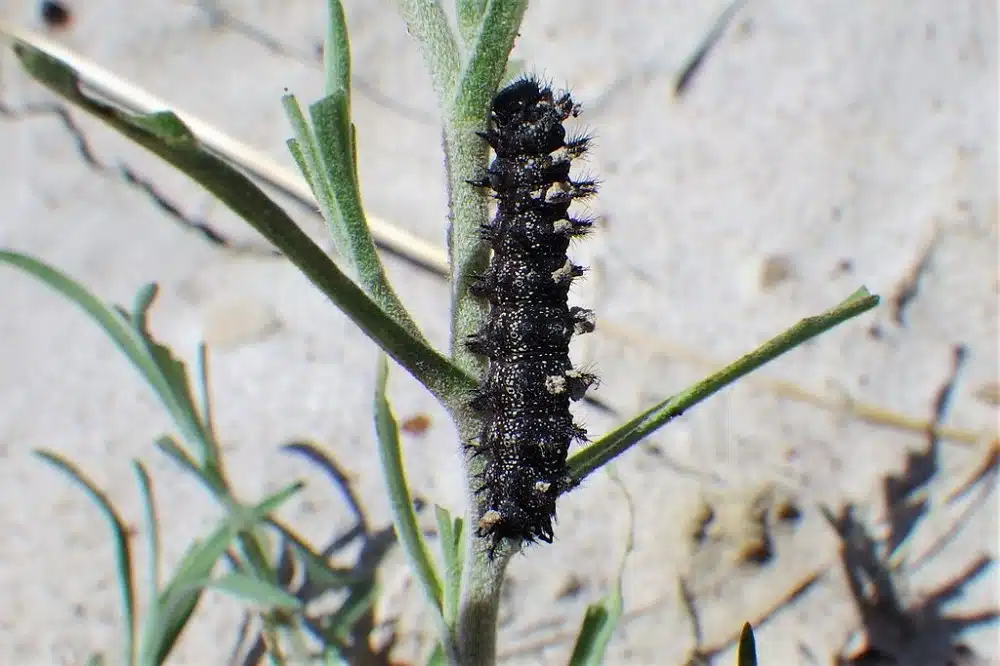
Sagebrush Checkerspots (Chlosyne acastus) are native to Western North American territories.
The species has an extensive habitat from Southern Canada to Northern Mexico.
It grows to mostly black caterpillars with tiny white dots.
This caterpillar prefers rabbitbrush plants as hosts. However, it has also been documented on various types of other plants.
You can find it on a wide range of wild sunflower-family plants.
Caterpillars of this genus are seen in 2 broods per year starting in June.
August is the last summer month the second brood can be seen in.
Once adults, the black color of the species remains important while its tiny white dots morph into large white dots across its wings.
26. Garden Tiger Caterpillar
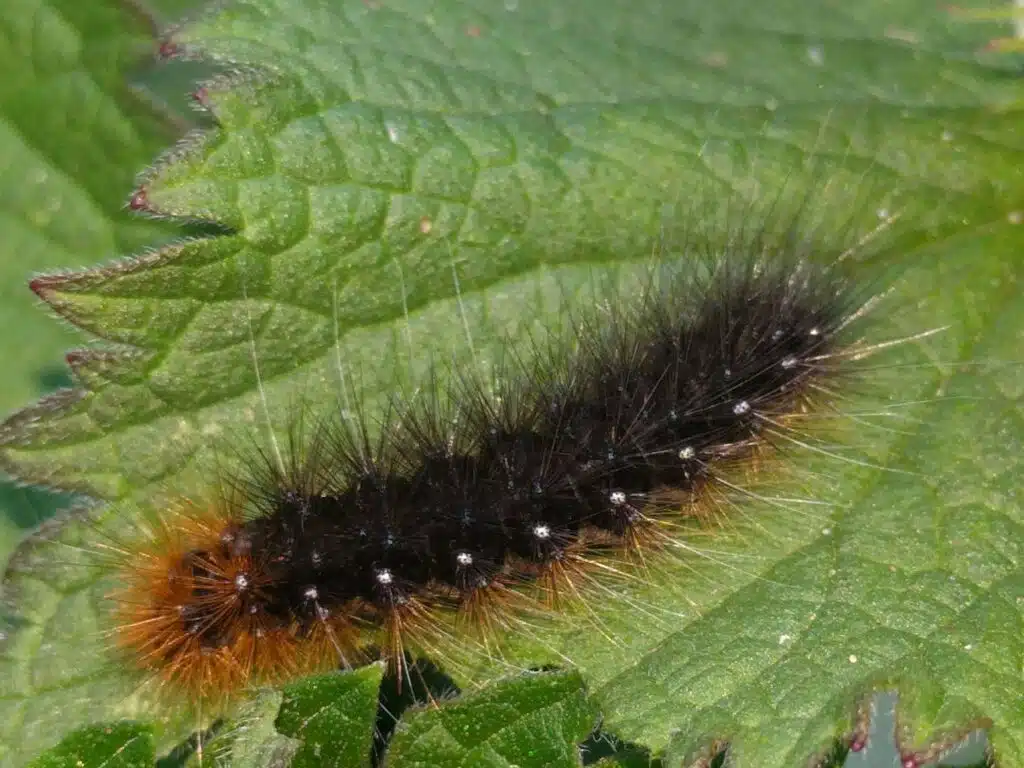
These types of caterpillars (Arctia caja) are among the multiple hairy species popularly referred to as Wooly bears.
It bears this nickname due to the numerous long hairs covering its body, making it appear fuzzy or covered in wool.
Black is the main dorsal color of the species. Brown is the secondary color, specific to the lateral sides of the species.
There’s no specific host plant for the Garden Tiger Caterpillar.
The extended range of plantango is what makes this species tied to this plan.
Foxglove flowers are colorful flowers that sometimes serve as an alternative host for the species.
27. Purple-backed Cabbageworm Moth Caterpillar
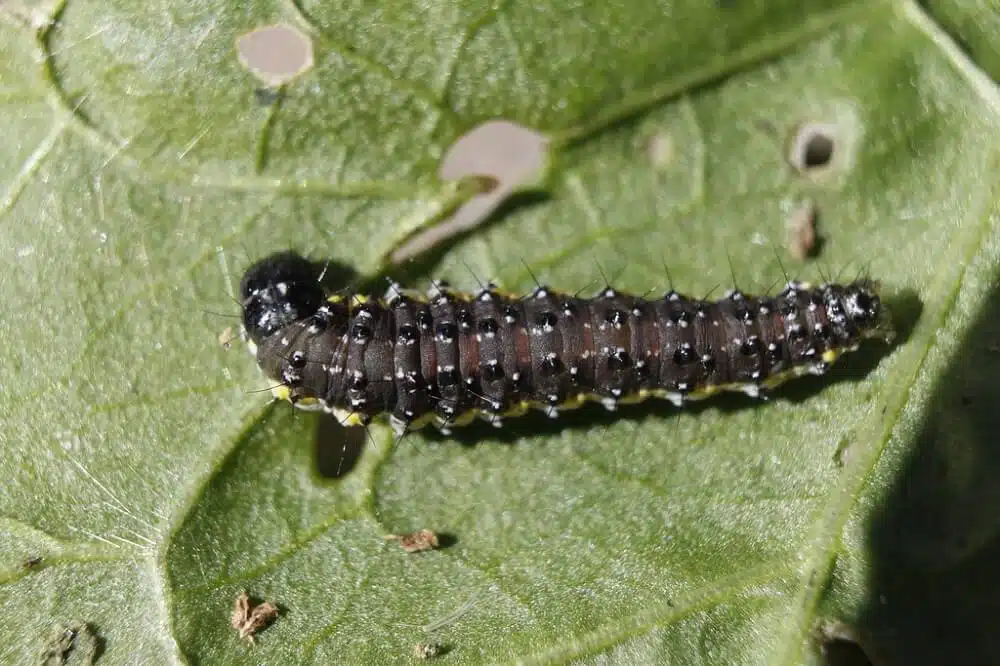
A dark brown to black color is specific to this caterpillar (Evergestis pallidata).
This caterpillar has a black nuance in its last instar and black spots in its first instars.
Purple-backed Cabbageworm Moth Caterpillars have a limited Northeastern US range with an occasional presence in Southern Canada.
You might find this caterpillar in your garden as it eats cabbage.
Apart from having a potentially negative impact on cabbages, this species has expanded to radishes and turnips.
Over time, this species has adapted to gardens and crops, as well as invasive plant species.
This is the main reason some Purple-backed Cabbageworm Moth caterpillars are sometimes seen on bittercress.
28. Snowberry Checkerspot Caterpillar
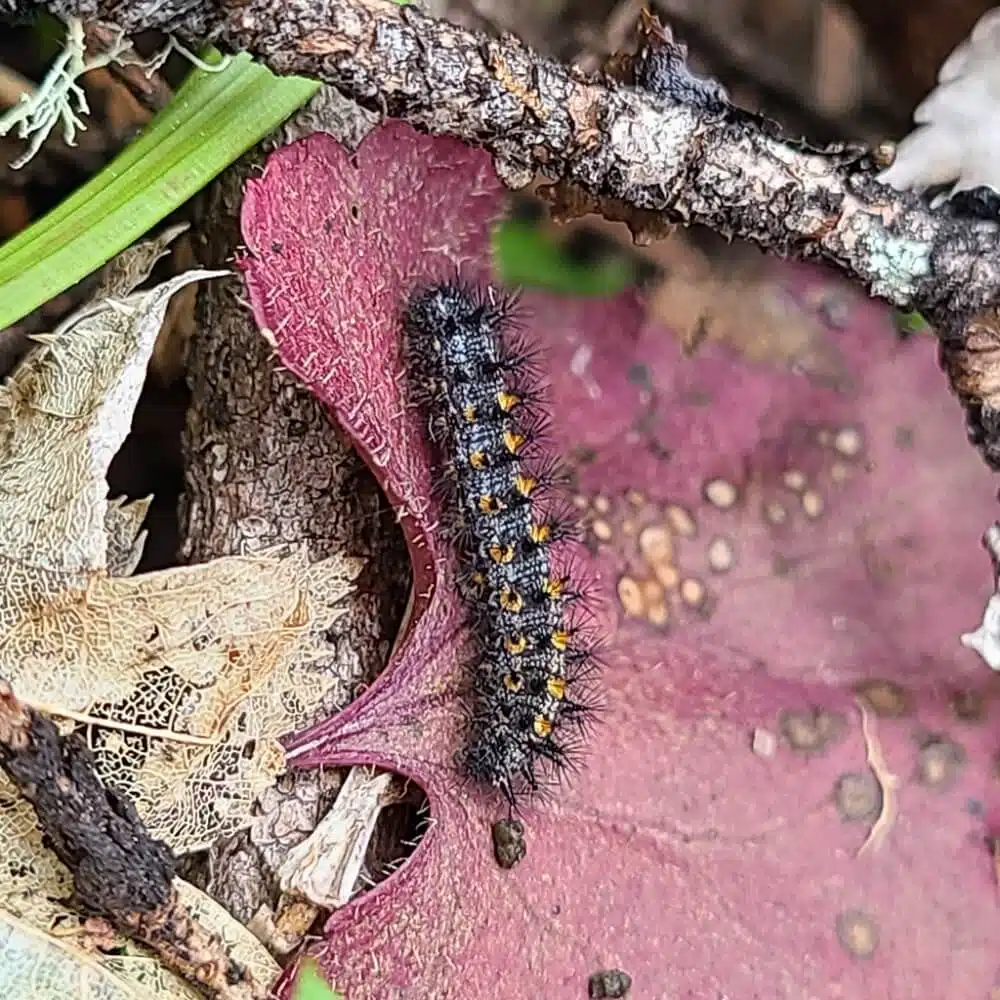
This type of caterpillar (Euphydryas colon) has a black base color across its dorsal and lateral sides.
It also has white, brown, and gray stripes decorating its body.
Native to North America, the Snowberry Checkerspot Caterpillar is among the species encountered in Northern California.
It prefers colorful flowers and plants as hosts.
This caterpillar is seen on purple, white, and yellow flowers.
Pink Common Snowberry are typical hosts for the species, together with Desert Penstemon flowers, which have darker pink coloring.
Foothill Penstemon flowers are among its favorite violet flowers.
Adults of the species are only partly black as their wings have a dark orange base color.
29. Lunate Zale Moth Caterpillar
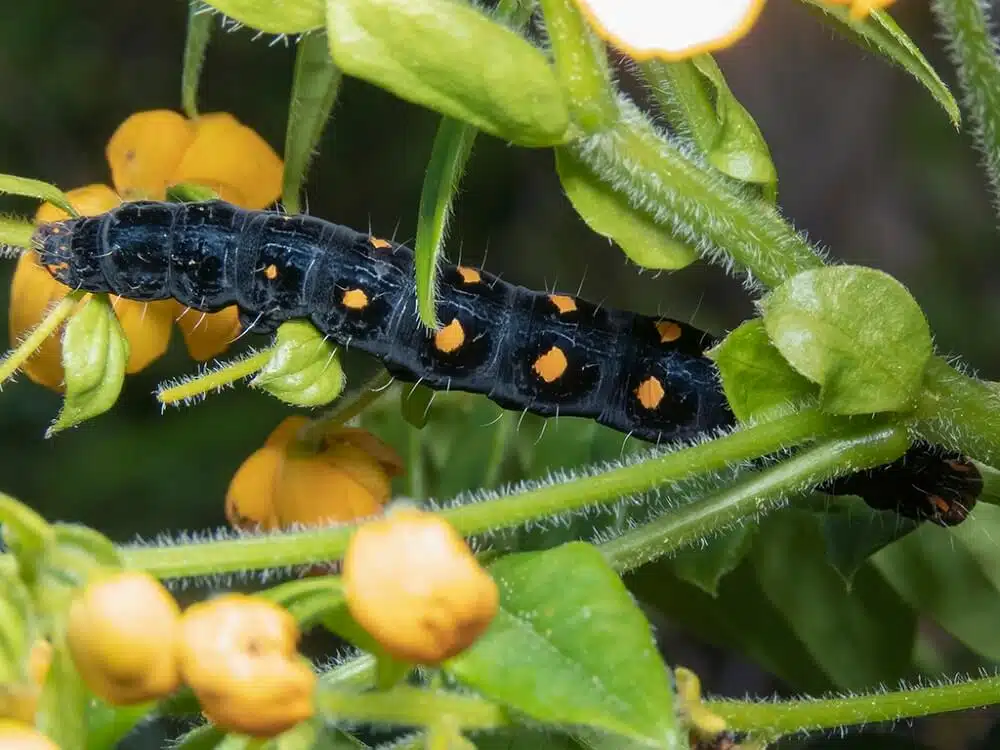
You can find this type of caterpillar (Zale lunata) across North America. Native to the continent’s woodlands, it’s a type of caterpillar that only makes it into gardens of homes next to woodlands.
It prefers to feed on hardwood trees which limits its habitat to deciduous woodlands.
Maple is among the most common host of the species.
Caterpillars of this genus feed on maple leaves while willows are secondary but still popular hosts of the species.
Adult moths are taken on darker camouflaging colors, similar to the caterpillars as well.
Brown and black coloring make the caterpillar a species similar to tree bark, which makes it hard to spot, just like the black caterpillar.
30. Yellow-striped Armyworm
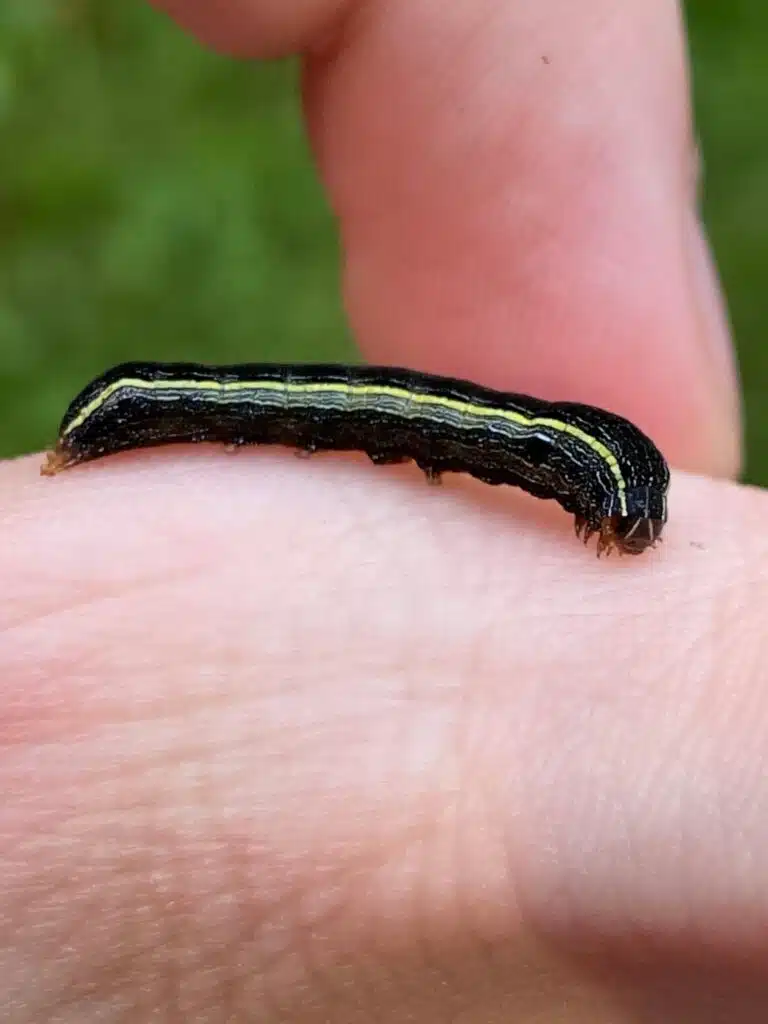
This type of caterpillar (Spodoptera ornithogalli) has a striped appearance. Wide black stripes, yellow stripes, orange stripes, and brown stripes make their appearance.
Black blotches are also seen across its body in its latest growth stages.
You might find these caterpillars in your garden if you plant tomatoes.
They can eat both tomato leaves and tomato fruits.
Yellow-striped Armyworm caterpillars are also seen on a few crops such as cotton fields where they cause significant economic losses.
Adult moths are brown, white, and yellow, with minimal black coloring.
31. Virginia Ctenucha Moth Caterpillar
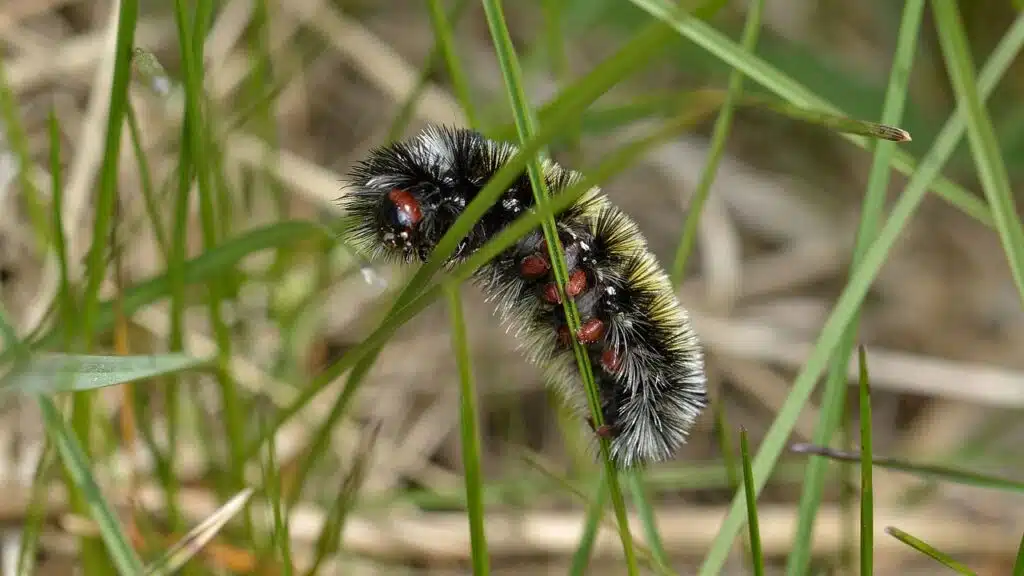
Long black hairs cover the entire body of the grown Virginia Ctenucha Moth Caterpillar (Ctenucha virginica).
White lateral bands contrast the black color of the species.
You can see this caterpillar across different habitats in Eastern North America.
Almost any type of tall grass can be a good host for the caterpillar.
Sedges are among the most common plants you can see Virginia Ctenucha Moth Caterpillars on.
This species initially has a white to lemon color but it turns black towards its later instars.
Adult moths of this genus bear the black color of the caterpillars. Mostly black, moths of this category can be seen feeding on nectar from various flowers in the garden.
32. Edwards’ Glassy-wing Moth Caterpillar
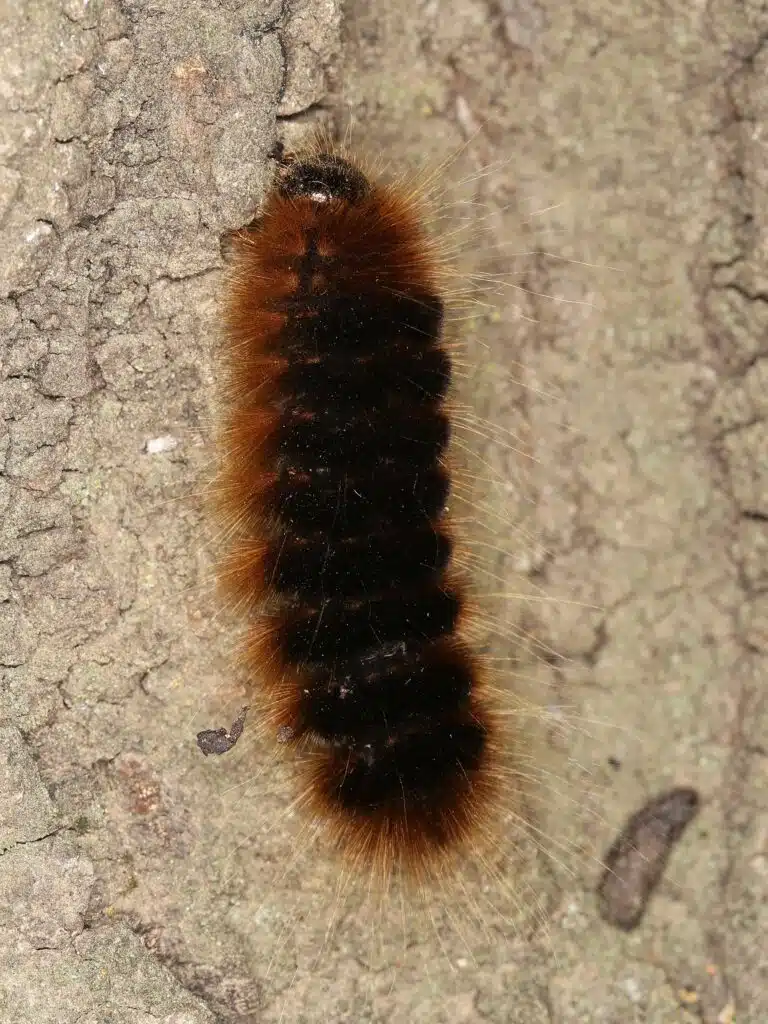
This type of caterpillar (Pseudohemihyalea edwardsii) is seen across North American woodlands. It has a black base color.
Long dense black hairs cover the entire body of the species.
Just a few lateral brown hairs are seen on the caterpillar.
Black coloring contrasts the green leaves it leaves and feeds on.
This type of caterpillar is mostly found in oak woodlands as it feeds on oak tree leaves.
California and Arizona oak are among the favorite hosts of the caterpillar.
Adults have the same colors as the caterpillar. However, adult coloring is inversed.
Brown is the main color across the wings while black is only present in small dots across the wings.
You can only see this species from late summer onwards to late fall in Southern US woodlands.
33. Clymene Moth Caterpillar
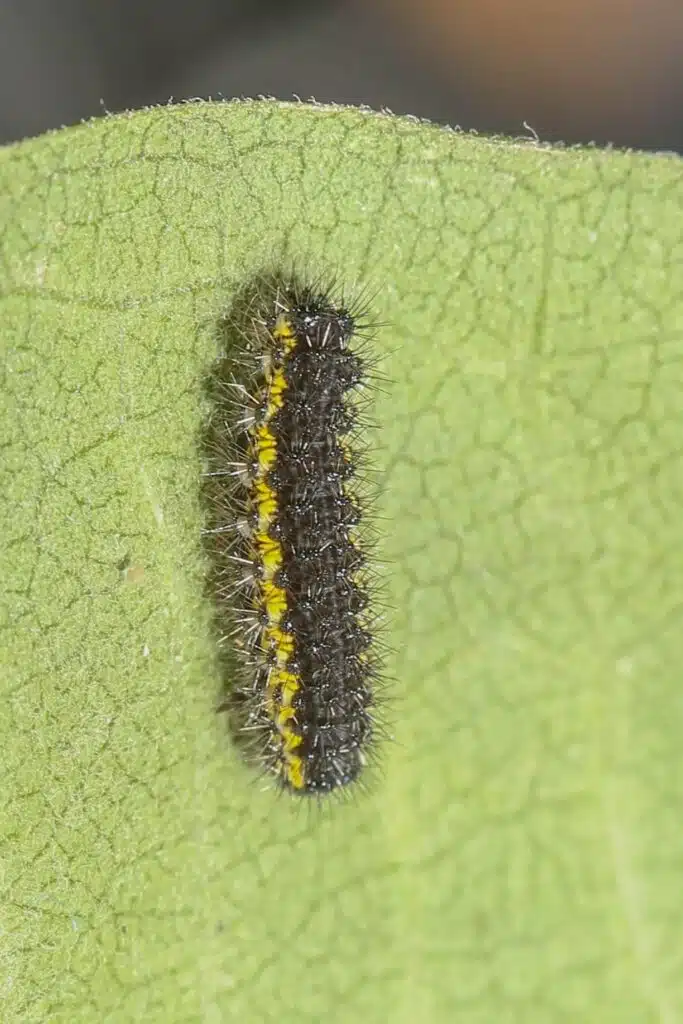
Clymene Moth Caterpillars (Haploa clymene) have contrasting coloring, a trait also seen in the appearance of adults.
Caterpillars of this genus are mostly black. They show a narrow yellow dorsal stripe in the early instars.
This dorsal stripe turns black in the late instars.
Wider yellow bands are seen across the sides of the species.
Short black hairs in tufts are seen on the sides of the caterpillar.
Adults of the species have a cream-white color with a black marking.
You can find both caterpillars and adults on asters and sometimes son trees such as oak and peach trees.
34. Reversed Haploa Moth Caterpillar
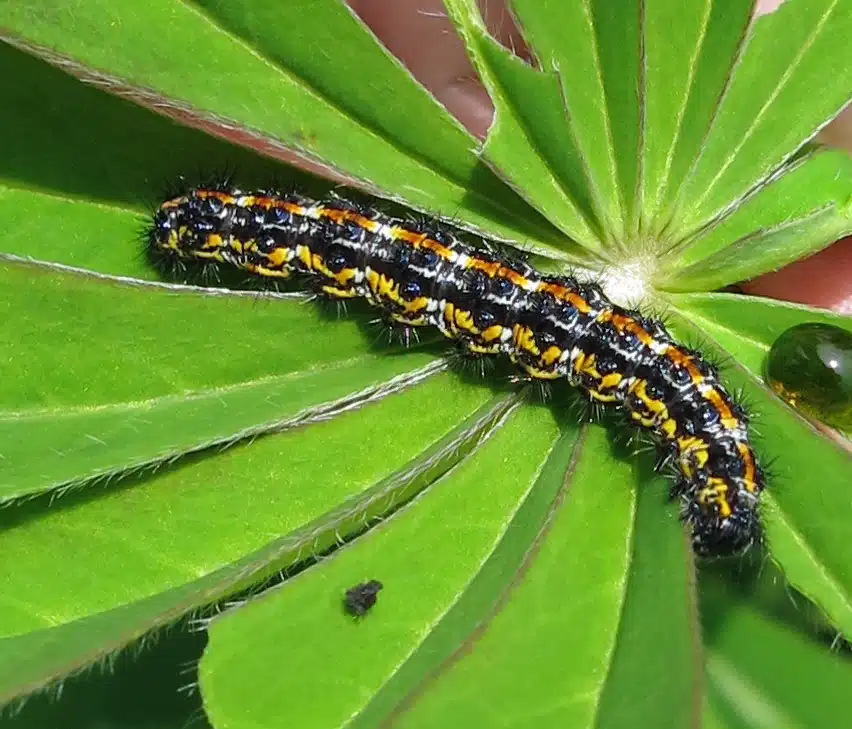
Moths of this genus (Haploa reversa) have a main black color.
Orange stripes and dots are seen across its body. The species also has rare short black or orange hairs.
Some of these colors are seen in different proportions on the adult moth as well.
Moths are white but they have black patterns across the forewings and an orange head, similar to the orange nuance of the stripes seen on the caterpillar.
You might find this type of caterpillar in your garden if you’re growing apple trees as this is the main host of the species.
A wide variety of apple trees are the host for the caterpillar.
Apple trees in Eastern and Central US states are among the most common hosts of the caterpillar.
35. Dull Firetip Caterpillar
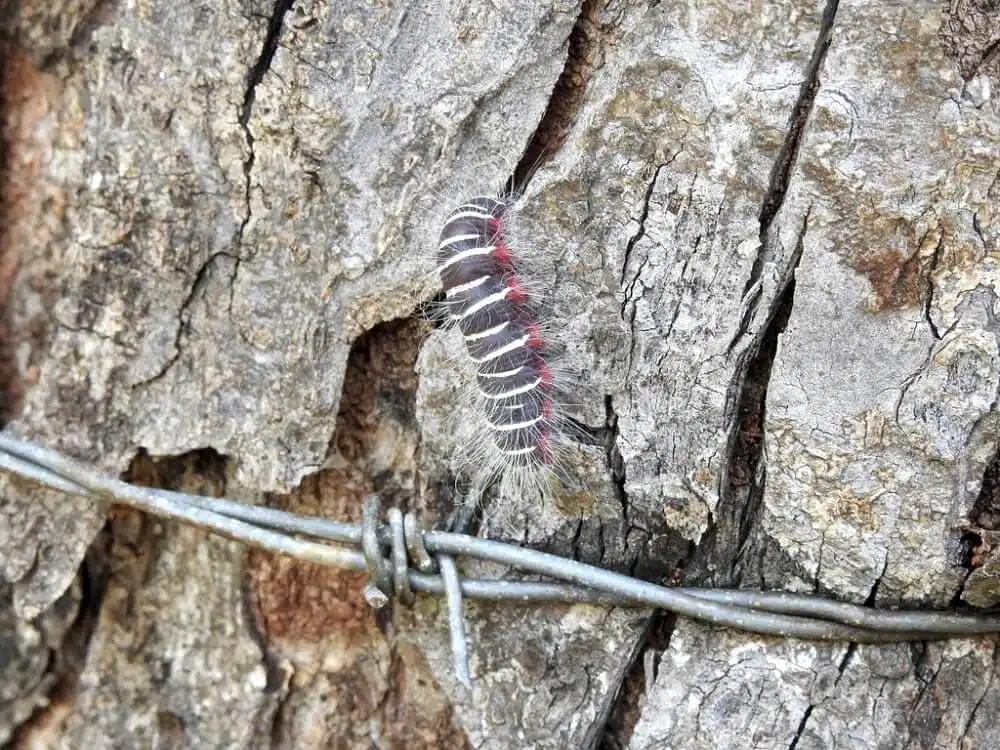
The brown-yellow Dull Firetip Caterpillar (Apyrrothrix araxes) has a black head and turns into a black pupa just before emerging as a brown butterfly.
Caterpillars of this family are among the species that overwinter in late instars.
A small nest in the form of a rolled leaf is a sign of an overwintering shelter for these caterpillars.
Most common on oak tree leaves, the caterpillars are native to North America.
Species such as the Arizona oak are among their favorite hosts.
Only one generation per year is characteristic of the Dull Firetip Caterpillar.
36. Cross-lined Wave Caterpillar
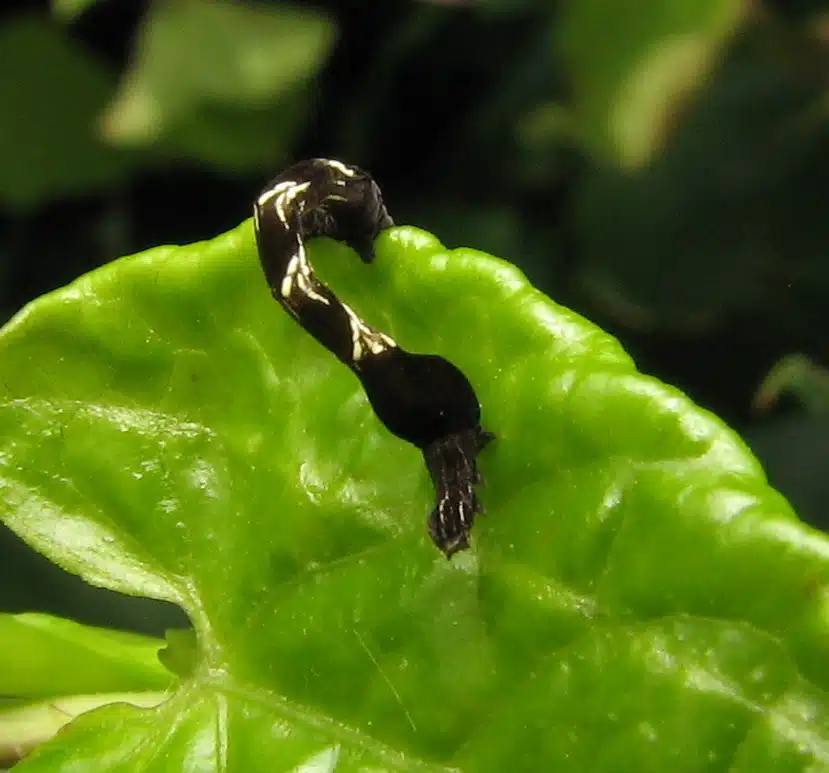
Cross-lined Wave Caterpillars (Timandra amaturaria) are found across Southeastern US states.
This caterpillar is believed to mimic snakes to keep predators away.
Also known as the Cobra inchworm, the Cross-lined Wave Caterpillar has the shape and coloring of a snake.
A wider triangular head is specific to the species.
While initially brown, this caterpillar eventually becomes black.
White diagonal stripes are also visible on this species in its later instars.
While living in warmer US habitats, the species is only seen from May onwards.
The species remains active until September.
You can find these caterpillars on host plants such as knotweed.
37. Straight-toothed Sallow Caterpillar
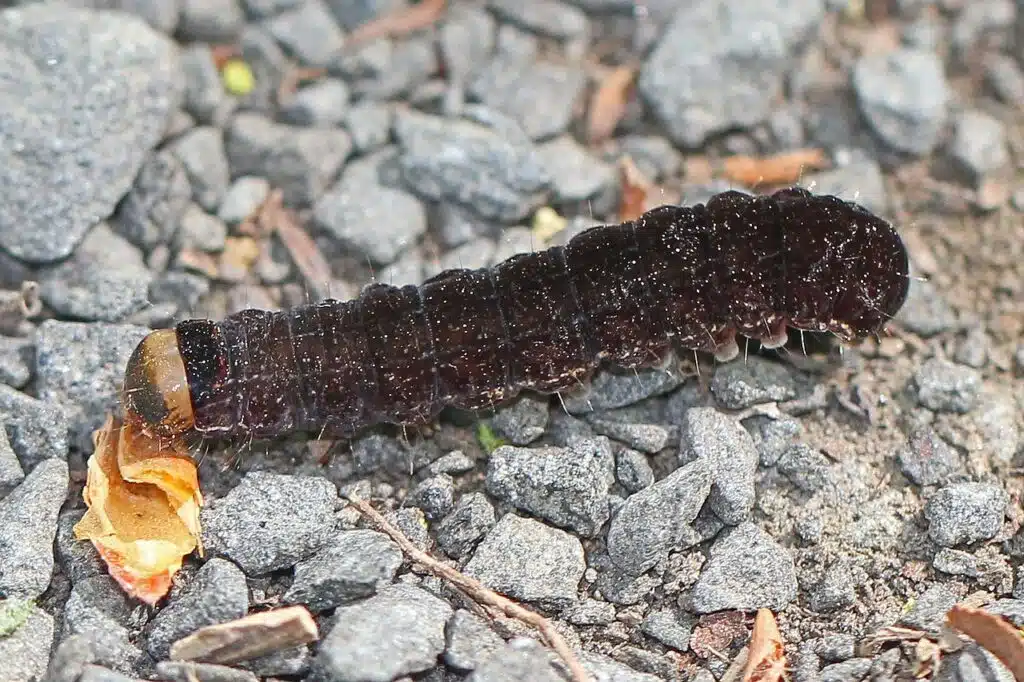
This species (Eupsilia vinulenta) begins life as a brown caterpillar.
It slowly turns black as it reaches its final growth stages.
White lateral bands are visible on the grown caterpillar, together with a brown head.
These types of caterpillars also feed on tree leaves. Box elder tree leaves are among the most common for them.
Oak tree leaves are also a very common host for caterpillars.
Once the adult moth emerges, it loses its black coloring in favor of lighter brown color combinations.
The hindwings of the adult are white while its body and its forewings are brown.
38. Theona Checkerspot Caterpillar
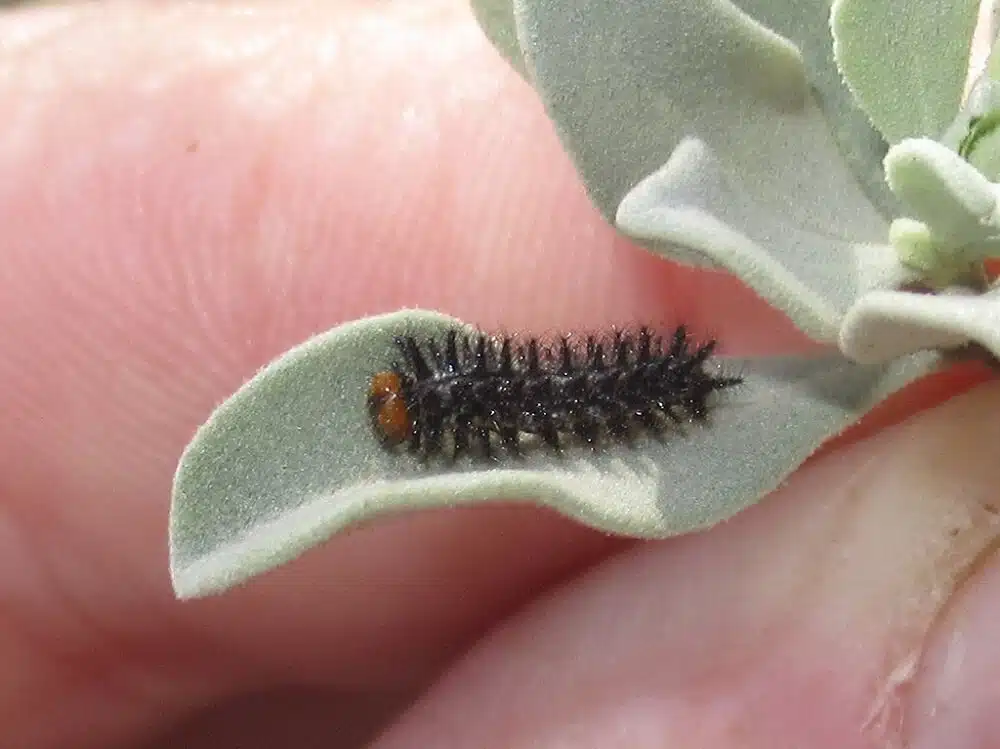
A North American native, Theona Checkerspot Caterpillars (Chlosyne theona) have black-brown colors, as seen on the adult butterflies.
The body of the species is mostly brown. Long black spines grow across its body almost covering it completely by the last instar.
Only the head and the anal plate remain brown on the species.
Found in New Mexico, Arizona, and Texas, this species feeds on various plants and flowers specific to warm or desert climates.
Paintbrush plants are the host of the species in areas with plenty of rainfall.
Desert foxglove is its host in arid lands of the South.
39. Regal Fritillary Caterpillar
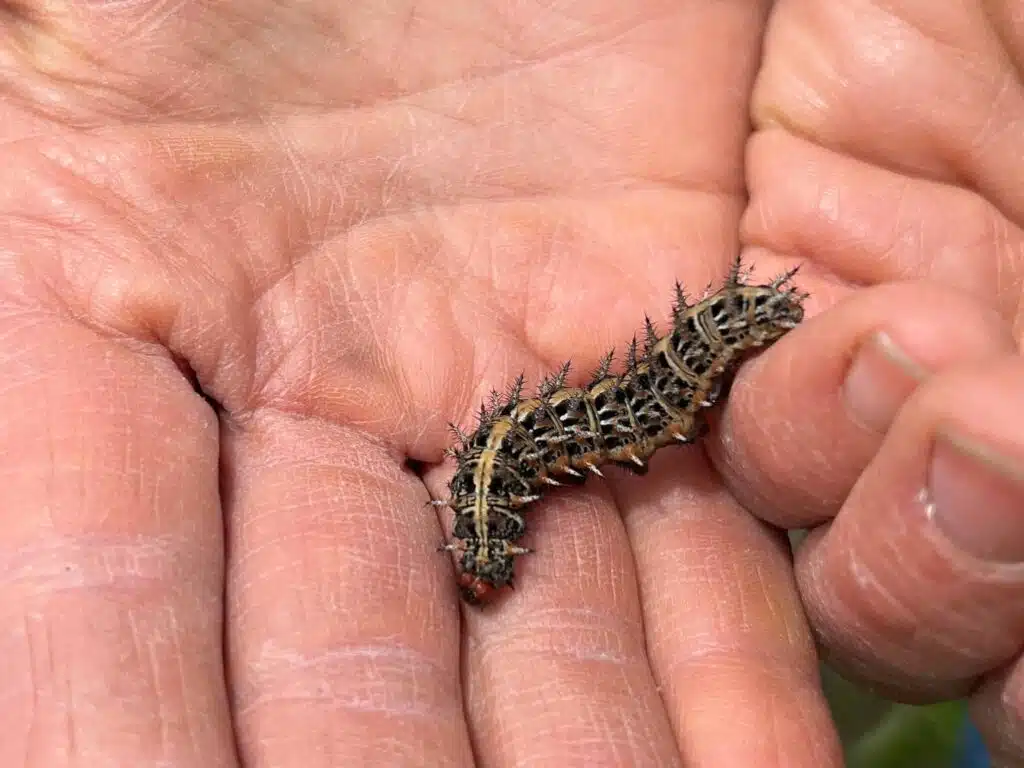
A black body is also characteristic of the Regal Fritillary Caterpillar (Speyeria idalia).
Orange contrasting stripes and bands are further distinguishable on the species.
These orange lines and stripes develop up until the last instars of the caterpillar.
The species is rather short as even a grown caterpillar never measures more than 1.7 inches.
Violets are among the most common hosts of the species. This is why you can see these caterpillars in your garden.
The more violets you grow the more caterpillars and butterflies of this family you’ll see.
Prairie violet is among the favorites of the species in large open areas where it can multiply in direct sunlight.
40. Funerary Dagger Caterpillar
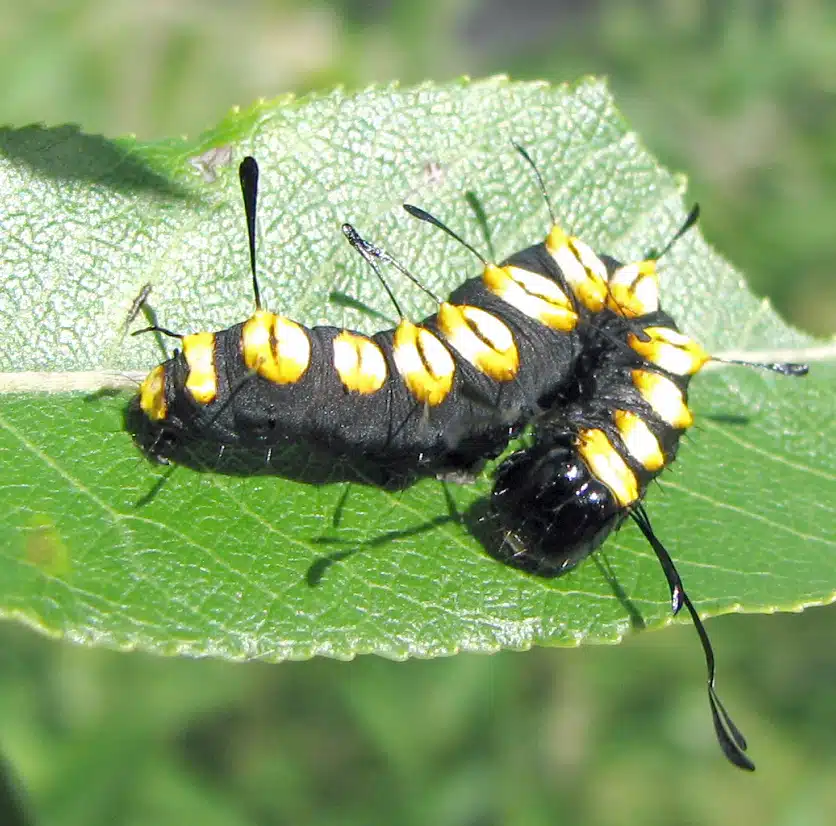
Funerary Dagger Caterpillars (Acronicta funeralis) have some of the most distinct patterns for a black caterpillar.
The body of the species is mostly black while the dorsal side shows large yellow circles.
These might make some birds or wasps take the caterpillars as poisonous.
A long list of tens of trees comprises the favorite hosts of this contrasting caterpillar.
Alder, hickory, and maple are among the tree leaves this caterpillar feeds on frequently.
Blueberries and apples are among the most common hosts of the species in gardens.
Various types of small willows are also hosts of the moth’s caterpillars.
41. Wilson’s Wood-nymph Moth Caterpillar
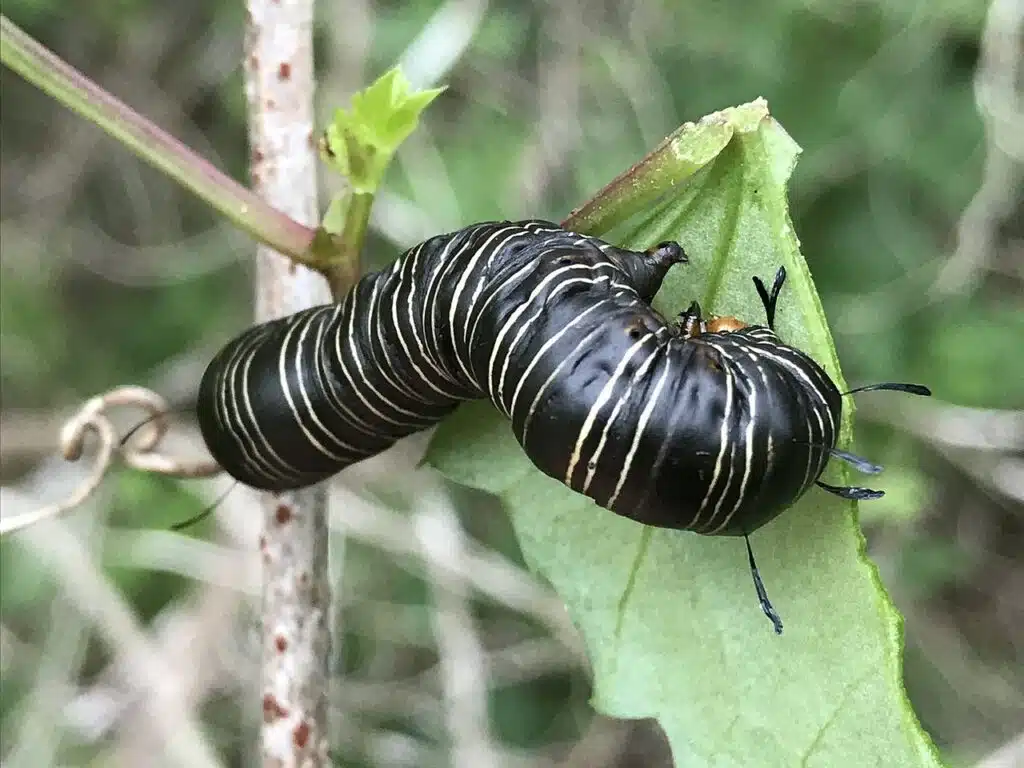
New Mexico and Texas are among the most common states where Wilson’s Wood-nymph Moth Caterpillar (Xerociris wilsonii) is native.
The Southern limits of the states represent the native habitat of the species in the US.
You can identify these caterpillars by their matte black body with white bands and black coloring between these bands.
Small brown eyespots are seen just behind its brown head.
Possum grapes are among the most common hosts of the species.
Feeding on vines, the species is known to have a base black color throughout its growth stages.
It eventually emerges as a white and black caterpillar.
42. Intermediate Hooded Owlet Caterpillar
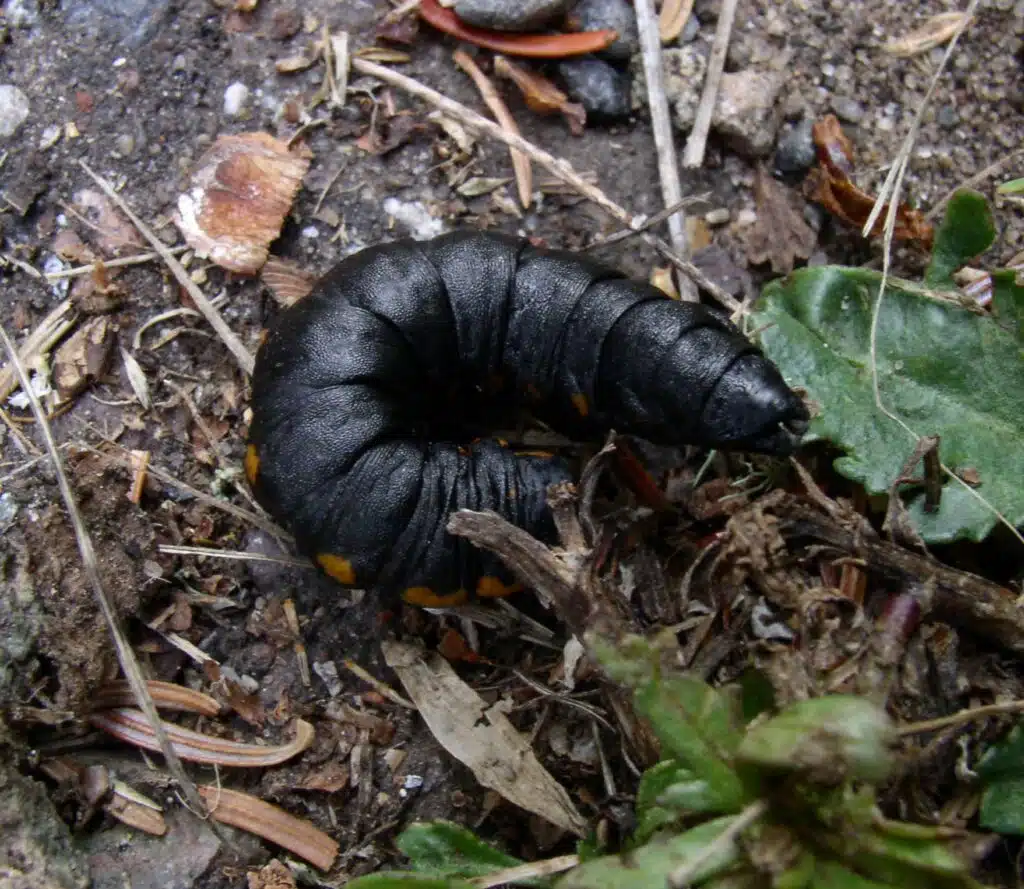
This type of caterpillar (Cucullia intermedia) appears black when seen from above.
Known for its robust body, it only has contrasting brown spots on the lower lateral sides.
It may be seen in gardens across the US, mainly on the West Coast states.
The caterpillar relies on lettuce flowers for food in gardens.
It can also grow and eat various trees that live in deciduous forests.
Oak tree leaves are a common sight for this black caterpillar, as are willows.
Once it emerges as an adult, it changes colors completely. The adult moth has a brown color with tan hindwings.
43. Sagebrush Sheep Moth Caterpillar
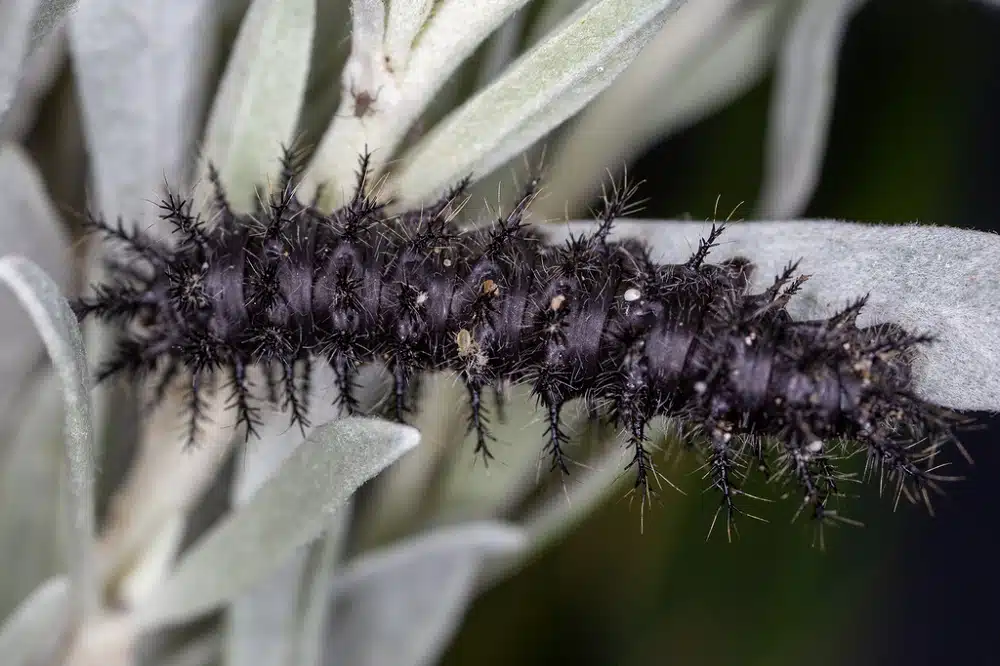
This species (Hemileuca hera) begins life as an all-black caterpillar. Brown spots appear on its body as it grows.
Long black spines also appear on the species as it grows.
The caterpillar isn’t known to be toxic, but many species stay away from it given it has long spikes.
You can find this species in different US habitats from Northern to Southern territories.
Lupines are among its favorite host plants on wide open land with short vegetation.
Big sagebrush plants are also a common host for the species.
Various other types of sagebrush plants are also hosting the caterpillar. They can be found even in arid conditions, mainly in areas with sporadic low vegetation.
44. Night-wandering Dagger Caterpillar
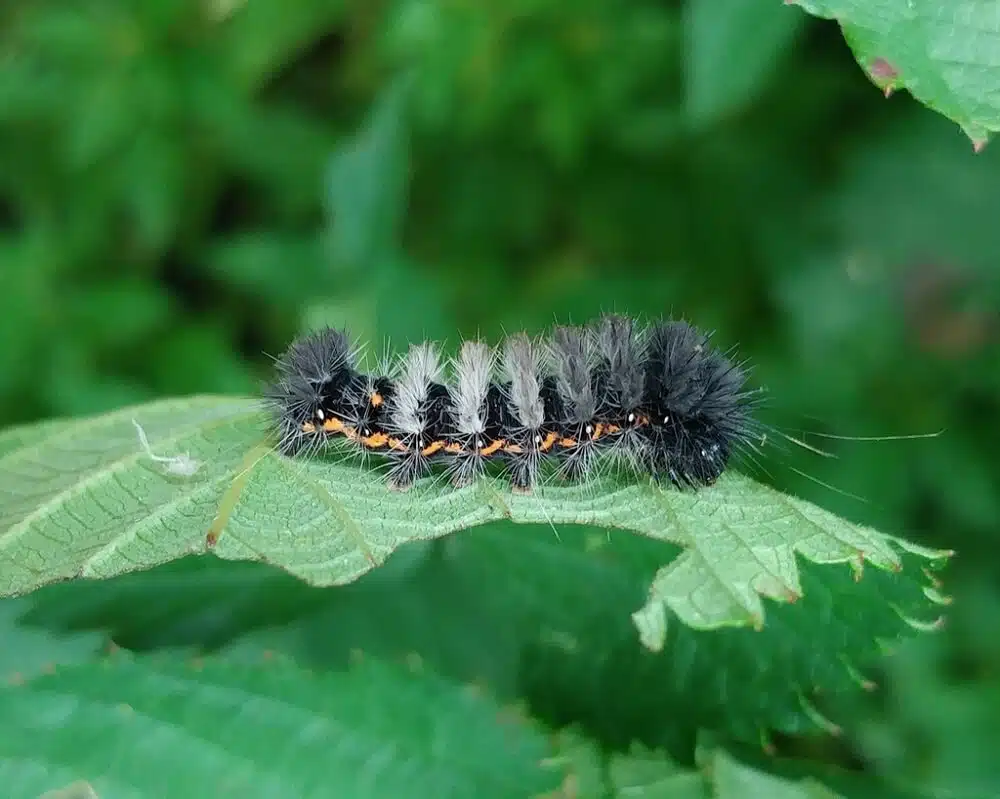
Black dominates the appearance of the Night-wandering Dagger Caterpillar (Acronicta noctivaga).
This is a species that has a base black color throughout all of its growth stages.
A black body with black tufts is specific to the species. Brown lines are seen on the lateral sides.
Moths of this species only partially carry caterpillar coloring into adulthood.
Night-wandering Dagger Caterpillars are mostly gray with black overlays across the forewings.
You may see this black caterpillar across various habitats in the summer.
It chooses poplar over other host trees.
This caterpillar may be seen in multiple broods as its season begins in May.
45. Large Tabby Caterpillar
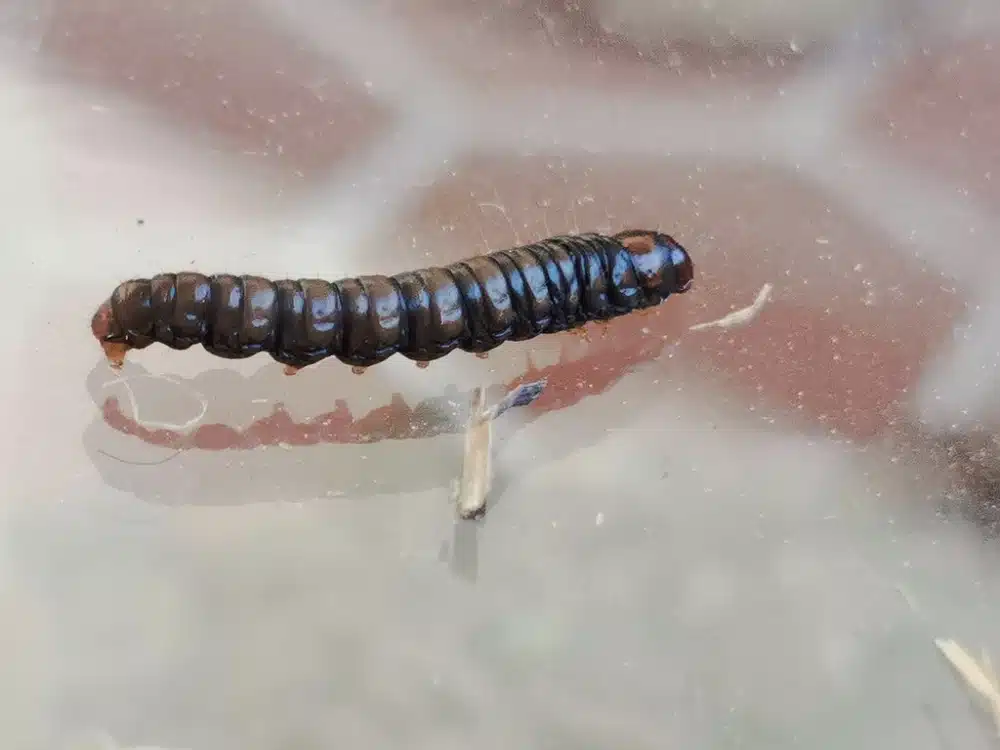
These caterpillars (Aglossa pinguinalis) are only seen at night. They have a black-dominant color with dark brown bands across the body.
Its brown sections eventually diminish towards the later growth stages and may turn into small dots.
Native to Europe, this is a caterpillar with an atypical diet as it prefers animal dung.
The caterpillar also feeds on dead animals.
It takes on the shape and color of dung for camouflage.
These caterpillars might also be difficult to locate as adult moths lay eggs in buildings, caves, and other shelters.
Adult moths also prefer to hide in these shelters during the day.
46. Black-dotted Brown Caterpillar
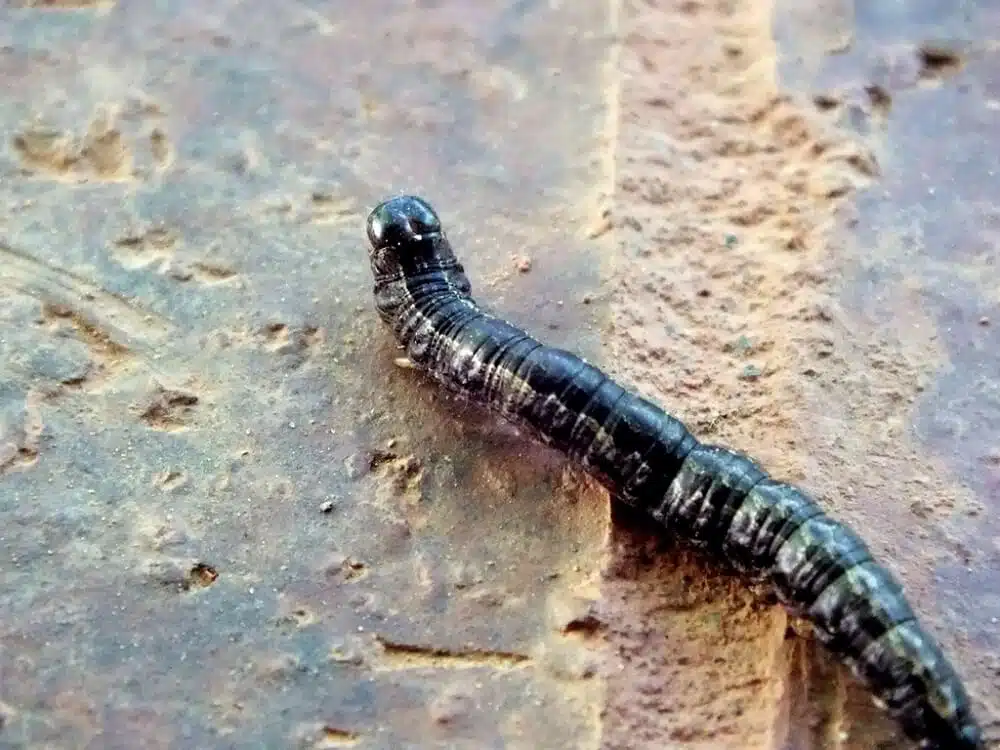
These large caterpillars (Cissusa spadix) have a gray-to-black body color with longitudinal black stripes.
A blackhead is also specific to the species.
Black-dotted Brown Caterpillars are found in Southern and Southeastern US territories.
These species are known for following oak buds of the season as they use different types of oak trees as host trees.
While these caterpillars may settle on other trees, they have a high preference for different types of oak such as red oak.
Once an adult, this species is known to only show black coloring across the body.
Its wings are brown and white.
47. Norman’s Quaker Caterpillar
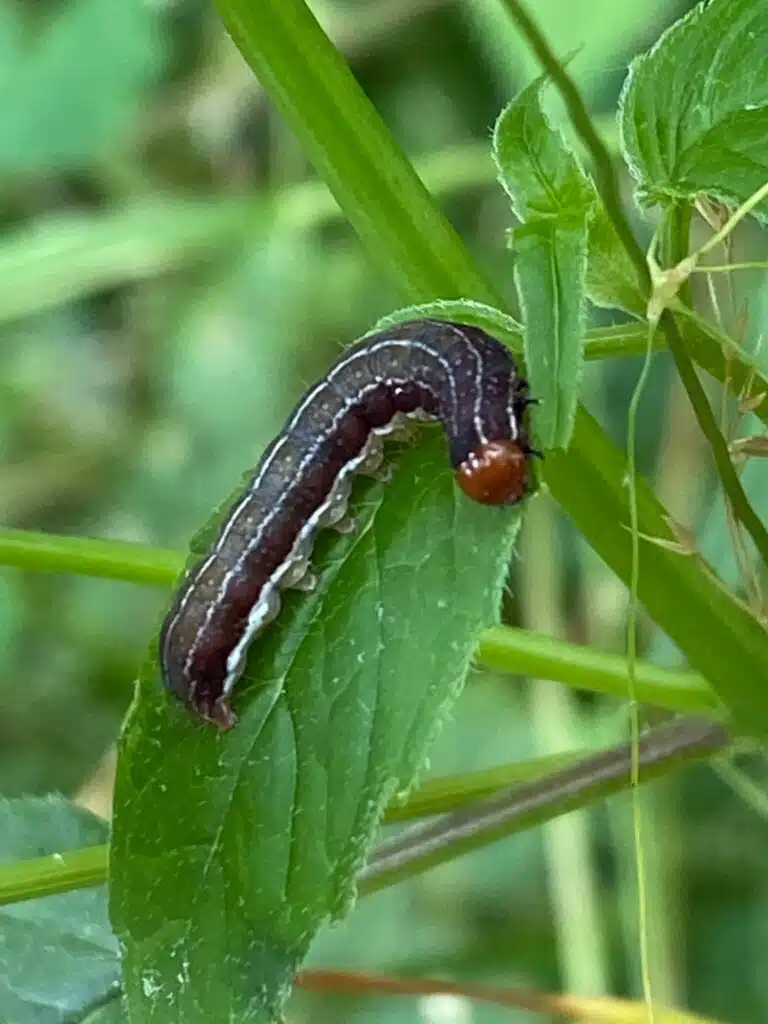
Black coloring is specific to the sides of this caterpillar (Crocigrapha normani). Its dorsal coloring is dark gray to green.
Tiny black and white dots are further seen across its body.
The head and anal plate of the species are brown and black.
Trees are the only type of hosts for these caterpillars. Willow, poplar, ash, and oak are among the most common host trees of Norman’s Quaker Caterpillars.
Caterpillars of this genus appear early in the season, together with some of the softest tree leaves they can feed on.
The coloring of the species changes once it turns into an adult.
Gray and brown are dominant colors in this species of moths.
48. Angus’ Datana Moth Caterpillar
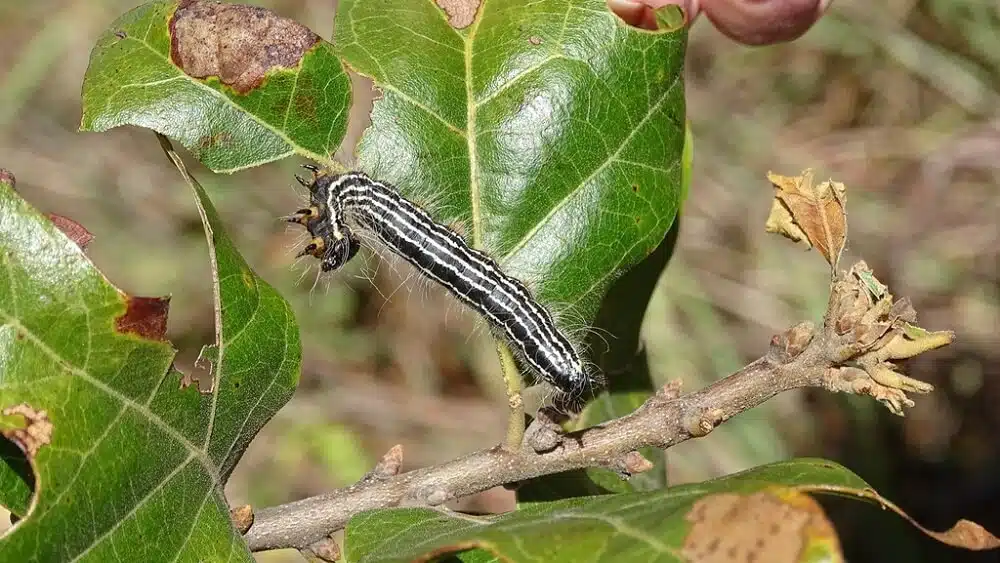
A black body and a black head are specific to this caterpillar species (Datana angusii).
White stripes run from the head to the anal plate of the species. Scarce white hairs are also contrasting the black body of these caterpillars.
This caterpillar can sting but it’s not poisonous or venomous to cause more than a skin-level rash or redness.
Caterpillars of this genus are sometimes found on walnut trees where they can’t do real damage in lesser numbers.
Exceptions apply to walnut trees where many of these caterpillars develop in high numbers.
They can eventually kill the tree by eating its leaves and stopping photosynthesis.
49. Neighbor Moth Caterpillar
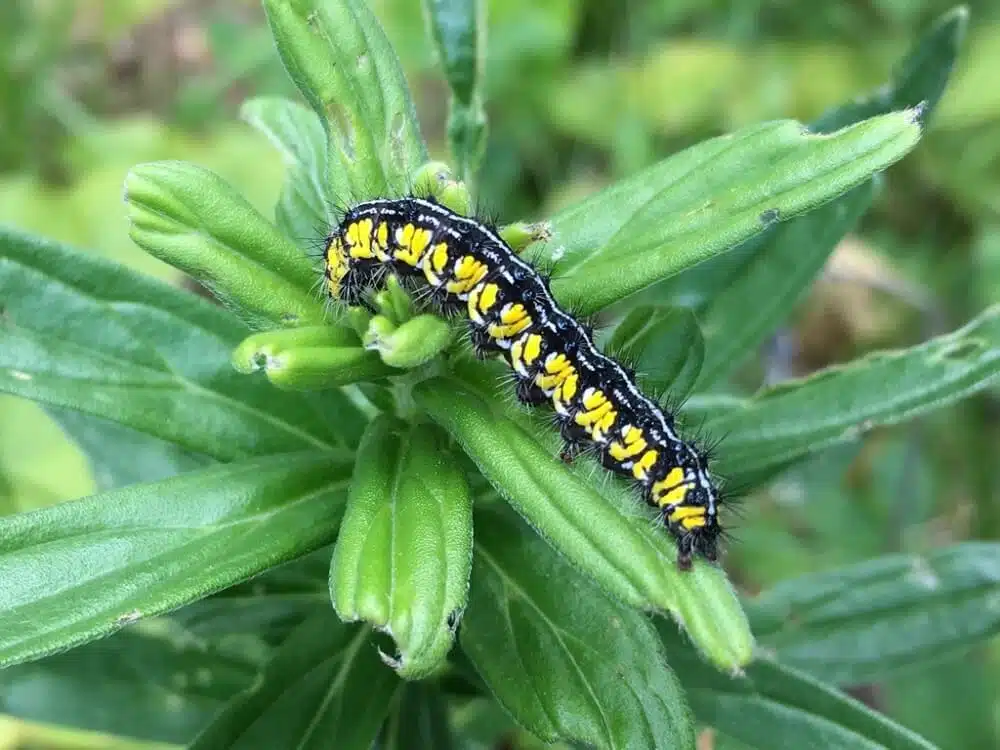
The black color with a white-yellow dorsal stripe is specific to this species (Haploa contigua).
These types of caterpillars show inverse colors as adult moths. White to yellow base coloring with black patterns is seen on the Neighbor Moth.
This species is native to Eastern and Northeastern North America.
It lives at high altitudes both in the US and in Canada.
Caterpillars of this genus are tied to American hazelnut as a host tree species.
Most times, their damage to the tree is superficial.
A considerable invasion can kill a hazelnut tree, on the other hand.
Hazelnut trees can grow to a size of up to 16 feet. This site might never be reached by a tree that suffers from a low-profile infestation with long-term leaf damage.
50. Grote’s Buckmoth Caterpillar
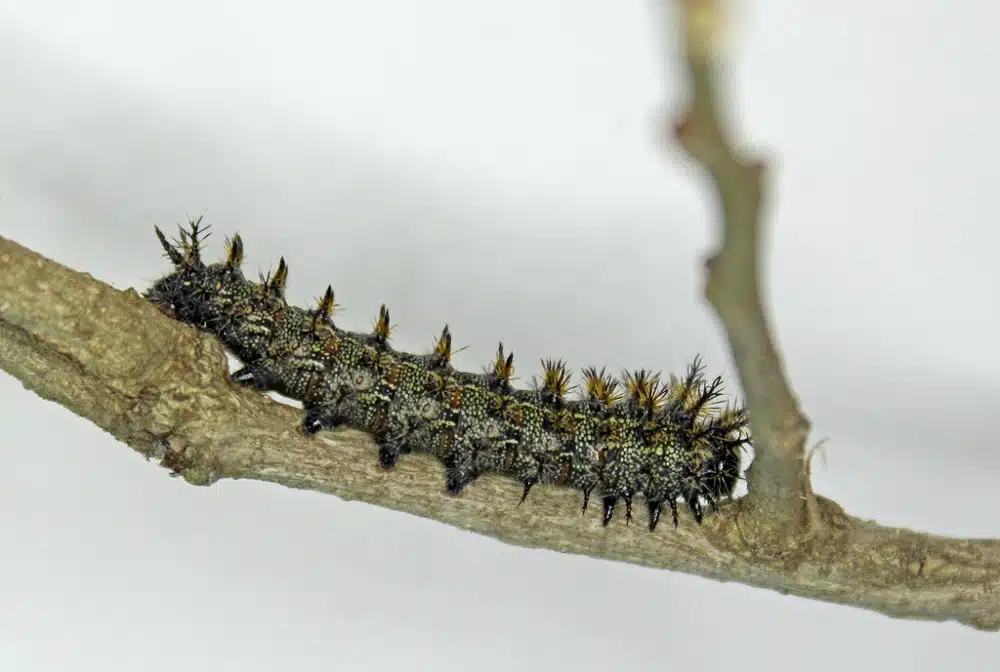
Central and Southern US states are natural habitats for Grote’s Buckmoth Caterpillar (Hemileuca grotei).
This is a species with a black body and tiny white dots.
Black coloring is also specific to the adult moth which is also mostly black with larger white marks across the wings.
Various types of oak trees are a host for the species.
Texas live oak is the main host across Texas.
You may also see this caterpillar on your oak in the backyard. Emory oak and scrub oak are also very common hosts for the black caterpillar regardless of the tree location.
51. Large Necklace Moth Caterpillar
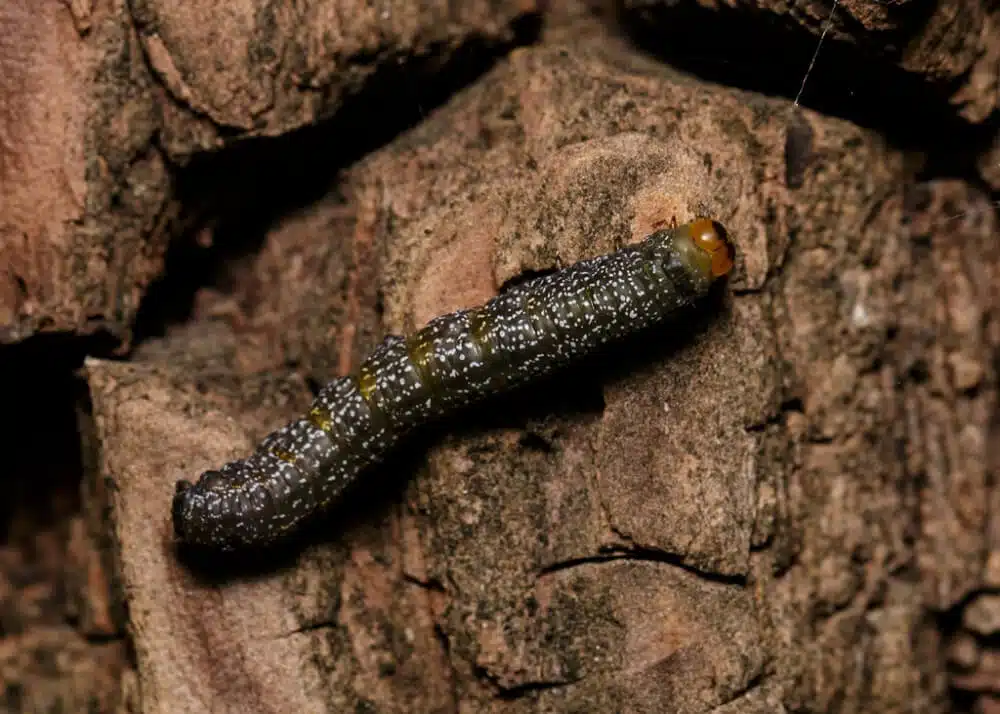
Dominated by a black color, this caterpillar (Hypsoropha monilis) shows tiny white dots across its body.
This species also shows a bright head and lateral bright stripes.
Common in the Eastern United States, the species is among the rare primary caterpillars feeding on the American persimmon or the Eastern persimmon.
This species appears in April, mainly at higher elevations where this tree grows.
None of the colors on the caterpillar are further visible on the adult which is mostly brown.
52. Indomitable Graphic Moth Caterpillar
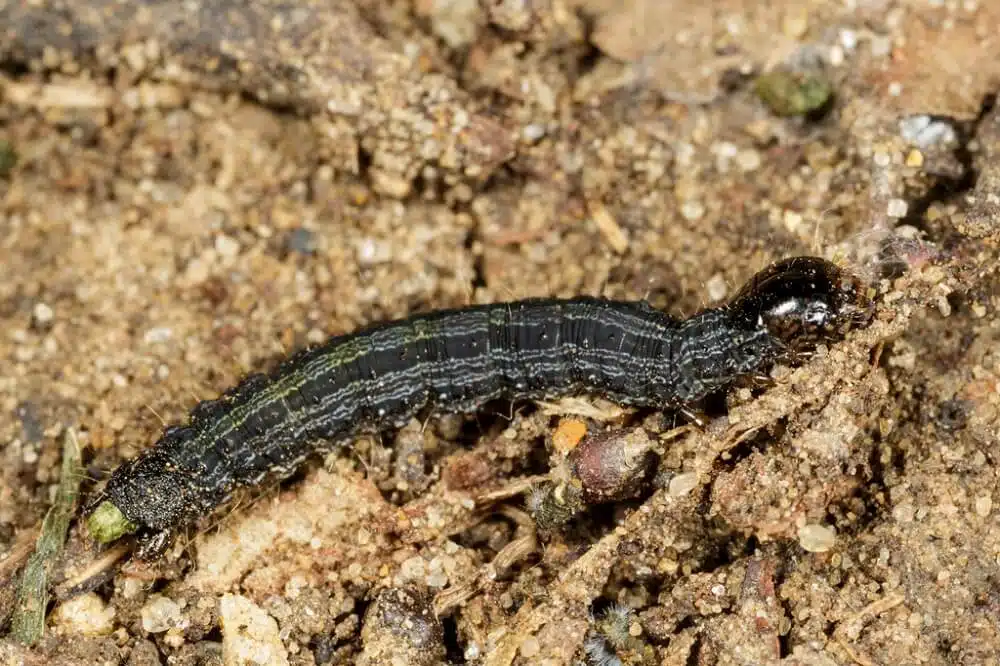
The black color with gray sections is specific to this caterpillar (Melipotis indomita).
The species is known to mimic twigs so that it doesn’t attract too much attention from its predators.
It can be found in Southern habitats, mostly in areas with mesquites, its host tree.
Adults of the species are seen feeding on almost any type of rotting fruit.
53. Southern Armyworm Moth Caterpillar
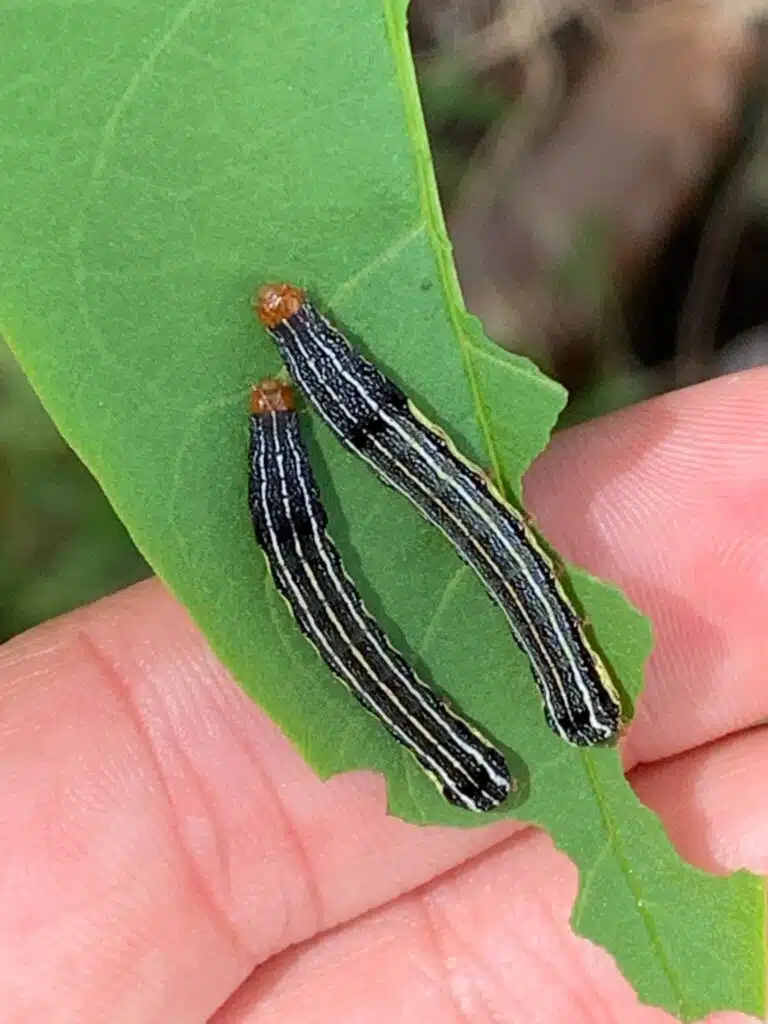
This black caterpillar (Spodoptera eridania) is one of the most common vegetable pests in Florida.
It feeds on a wide range of decorative plants as well as a few other vegetables.
You can find it in gardens feeding on cabbages, carrots, eggplants, and other types of vegetables.
Damages to vegetables are always considered and insecticide application is always necessary to combat it on crops.
54. Arge Moth Caterpillar
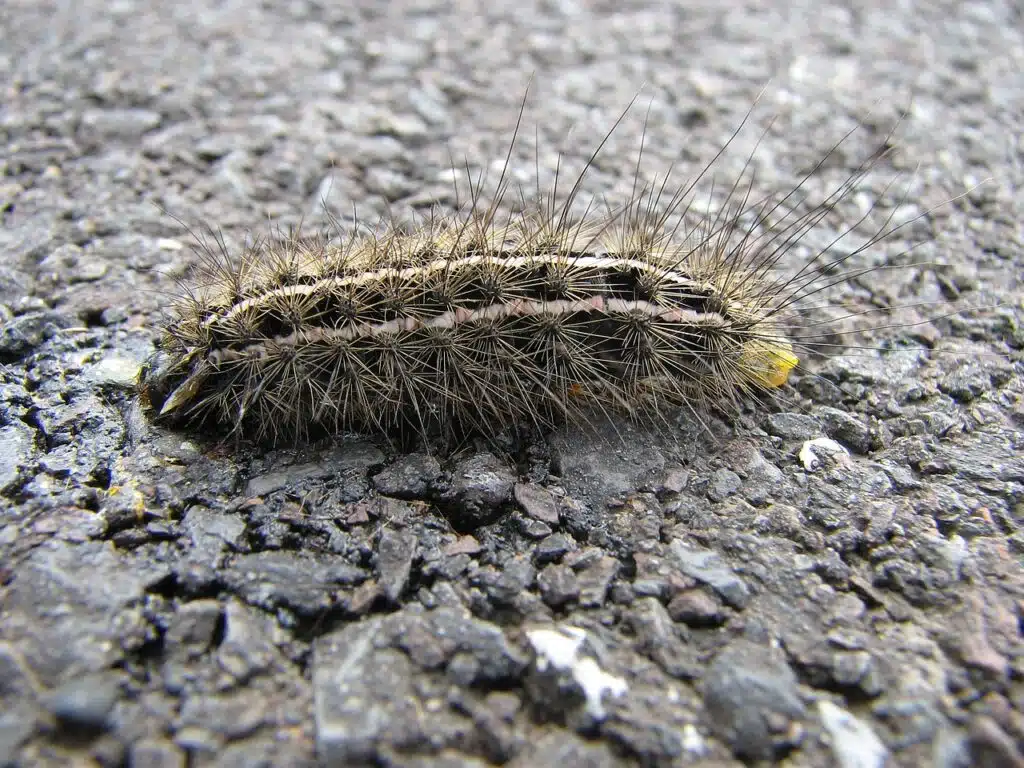
Arge Moth Caterpillars (Apantesis arge) are urticating caterpillars.
They have long spikes which can cause skin irritation and temporary pain when handled by accident or on purpose.
Its body is mostly black with white longitudinal stripes.
You can find this species in parks and gardens on plantain. It also feeds on corn.
55. St. Lawrence Tiger Moth Caterpillar
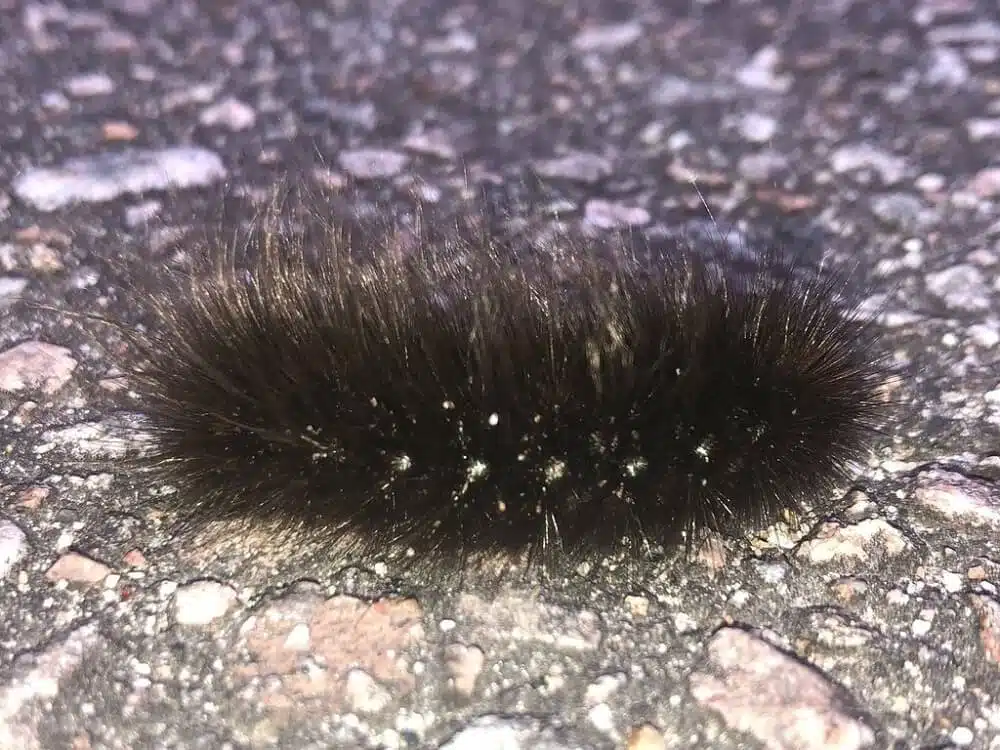
This black caterpillar (Arctia parthenos) is known to come to life in the spring after overwintering as larvae.
Overwintering in different growth stages is characteristic of the species.
This native caterpillar is one of the minor tree pests on walnut and willows.
Adults of the species bear little resemblance to the caterpillars as they’re mostly brown.
You can find this species in all US territories, including Alaska.
56. Gray Buckeye Caterpillar
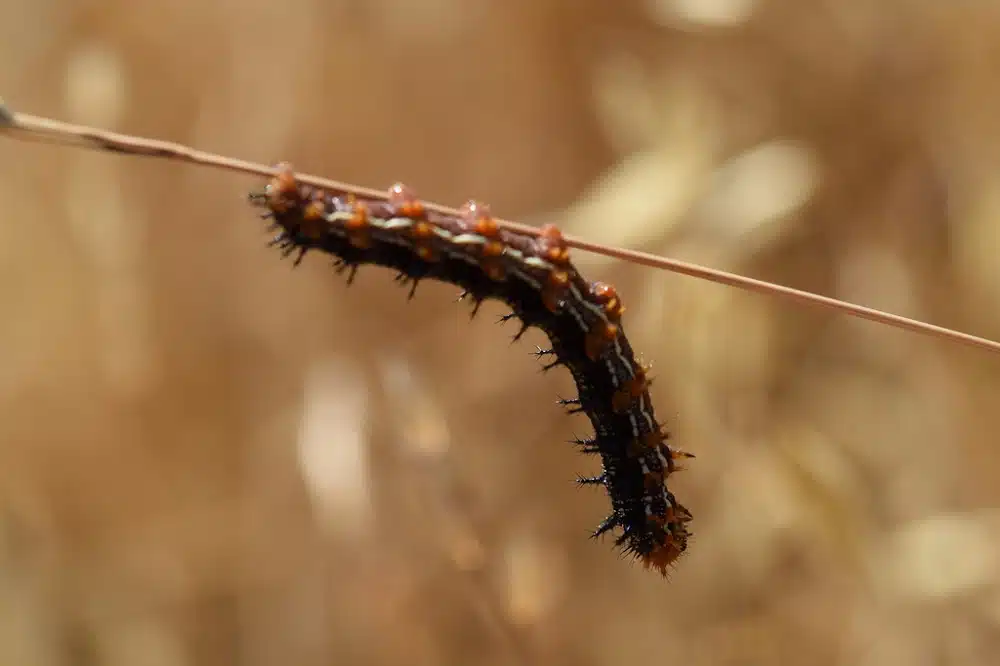
This caterpillar (Junonia grisea) has a black body and brown legs.
It’s one of the recent discoveries in North America as it was believed to be part of the Common Buckeye species.
A separate species today, this caterpillar only turns into a butterfly similar to the Common Buckeye as an adult.
It can be found on the Western Coast.
Much of the black and brown nuances of the caterpillar are distinguishable on the wings of the adult.
57. Twintip Buckeye Caterpillar
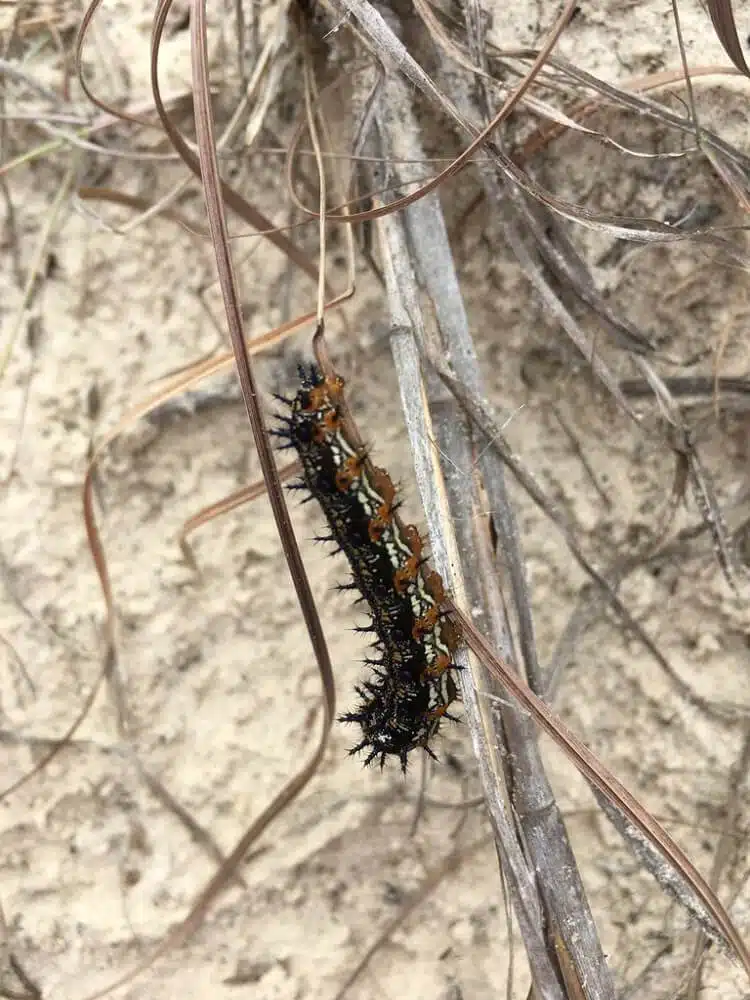
Similar to the Common Buckeye, this species (Junonia stemosa) appears darker through its life stages.
The caterpillar is mostly black with black spikes. It has brown lateral marks and brown legs.
Like the Gray Buckeye Caterpillar, the Twintip Buckeye Caterpillar is also a new species.
Its range isn’t exactly known today outside Southern Texas. It’s this Southern territory where the species is commonly known as The Dark Common Buckeye, even if it’s a separate species.
Unlike the Common Buckeye Caterpillar, the Twintip Buckeye Caterpillar exclusively feeds on Gray-wooly twintip plant leaves.